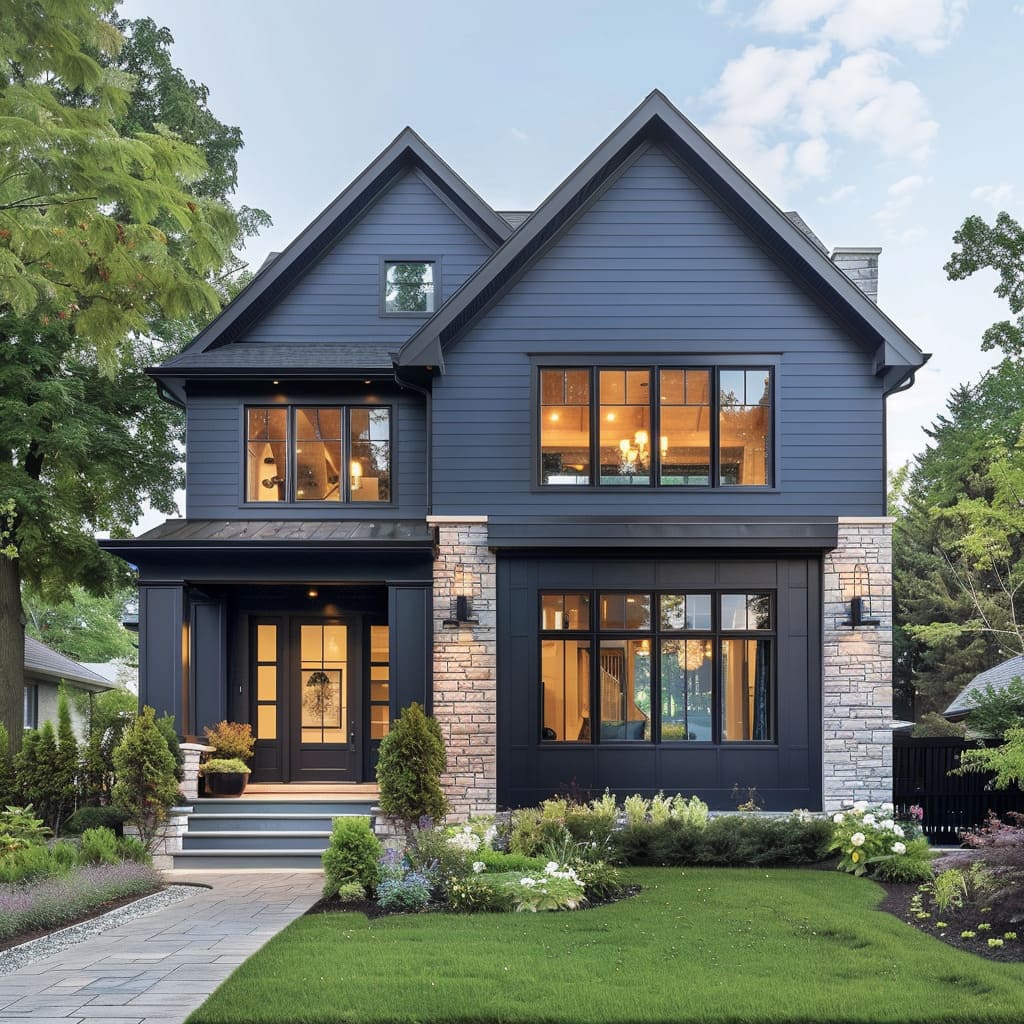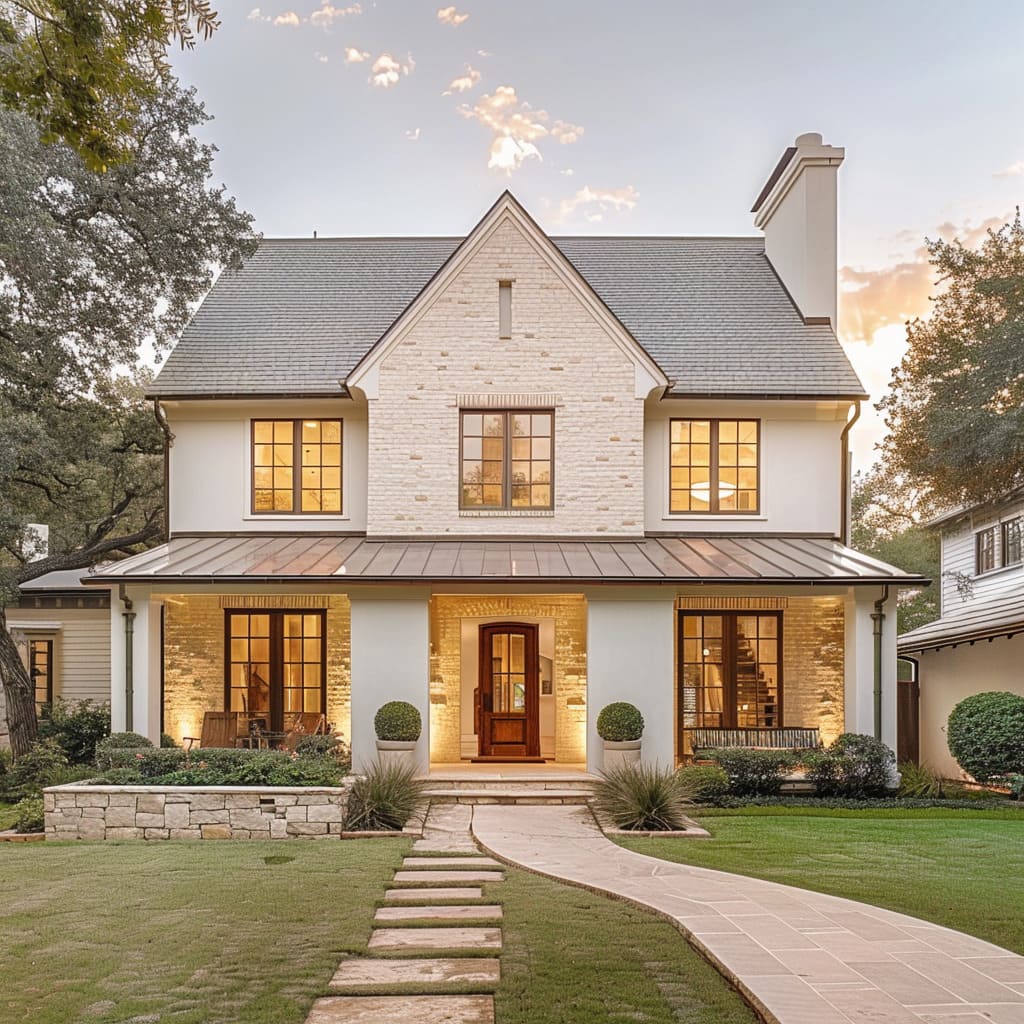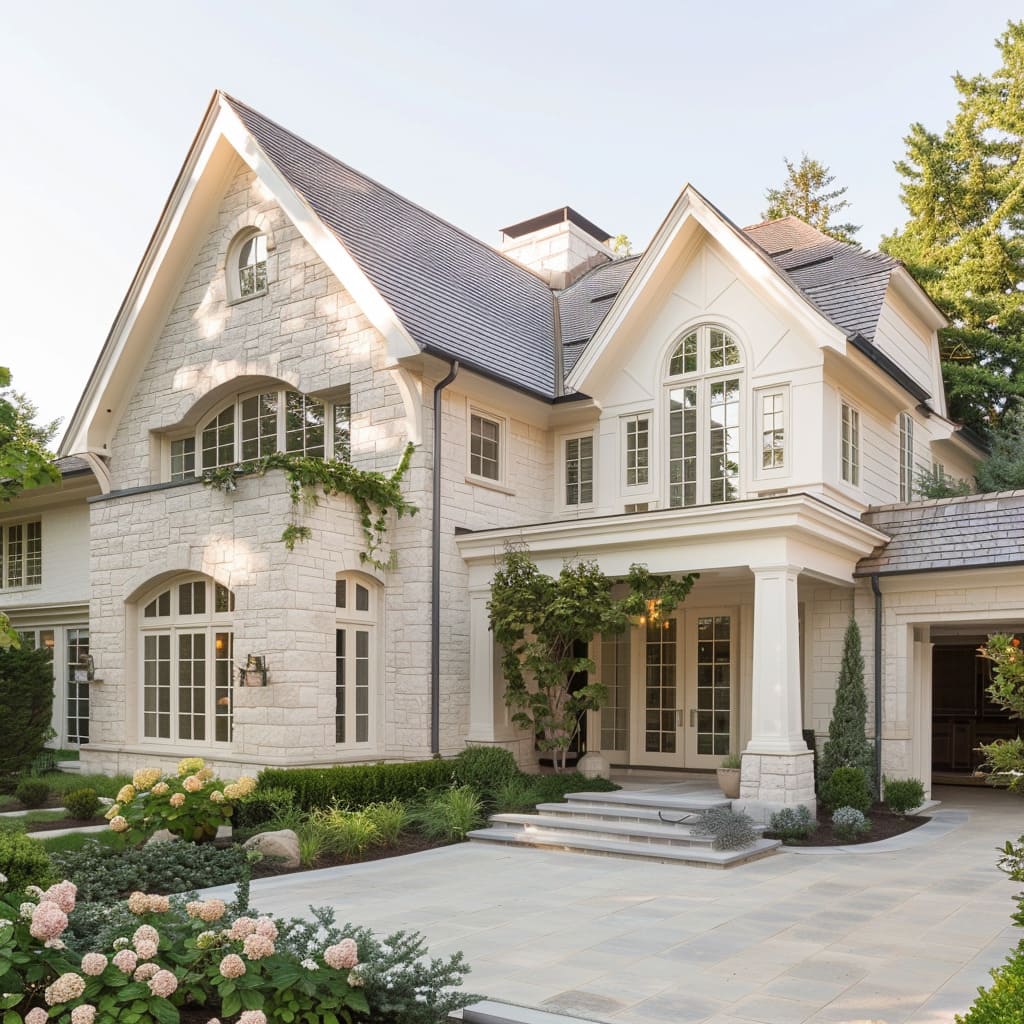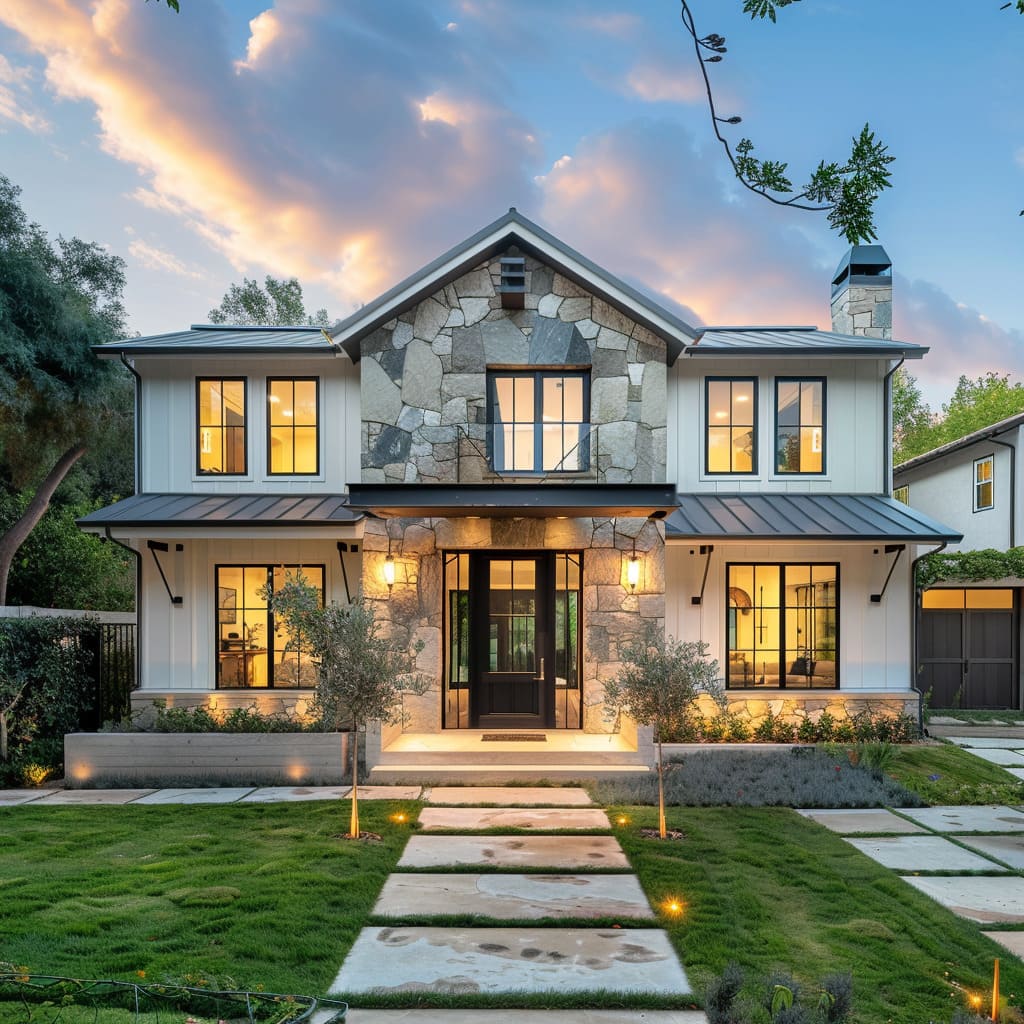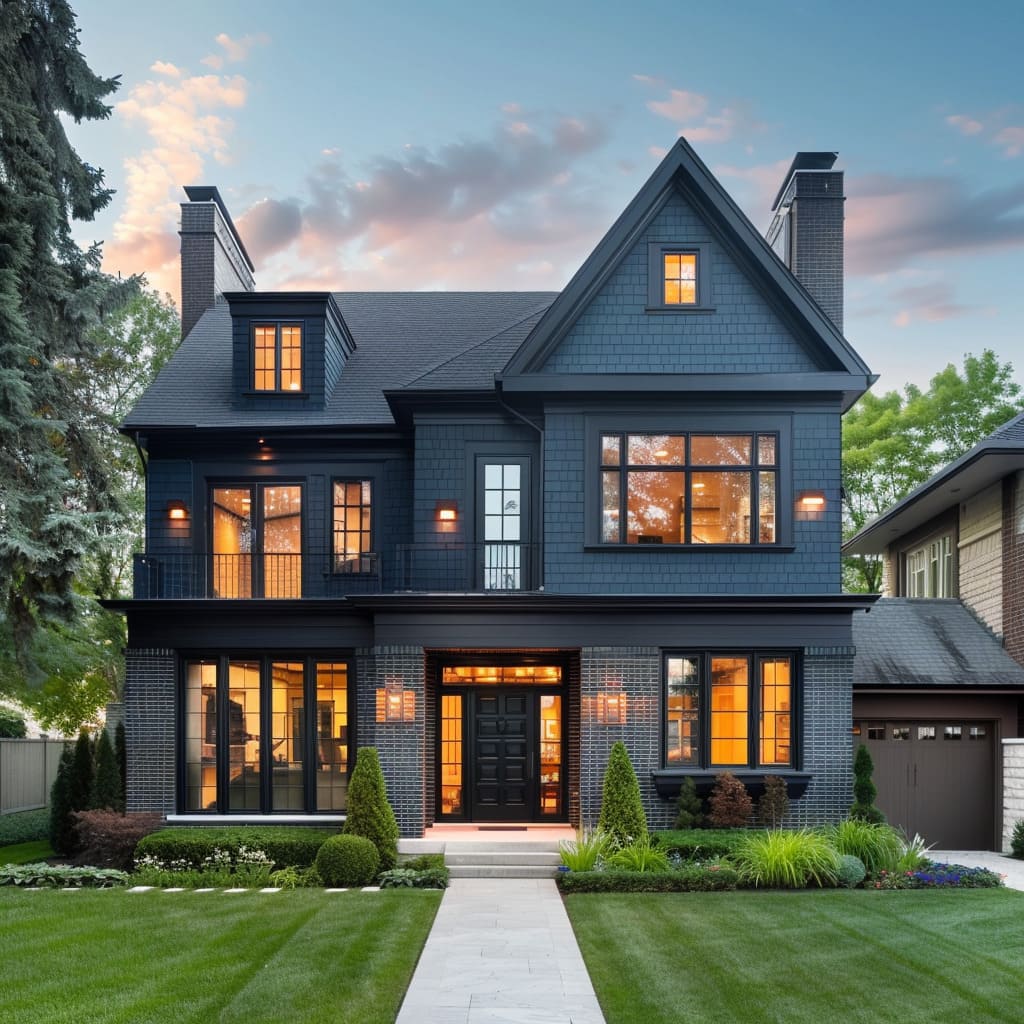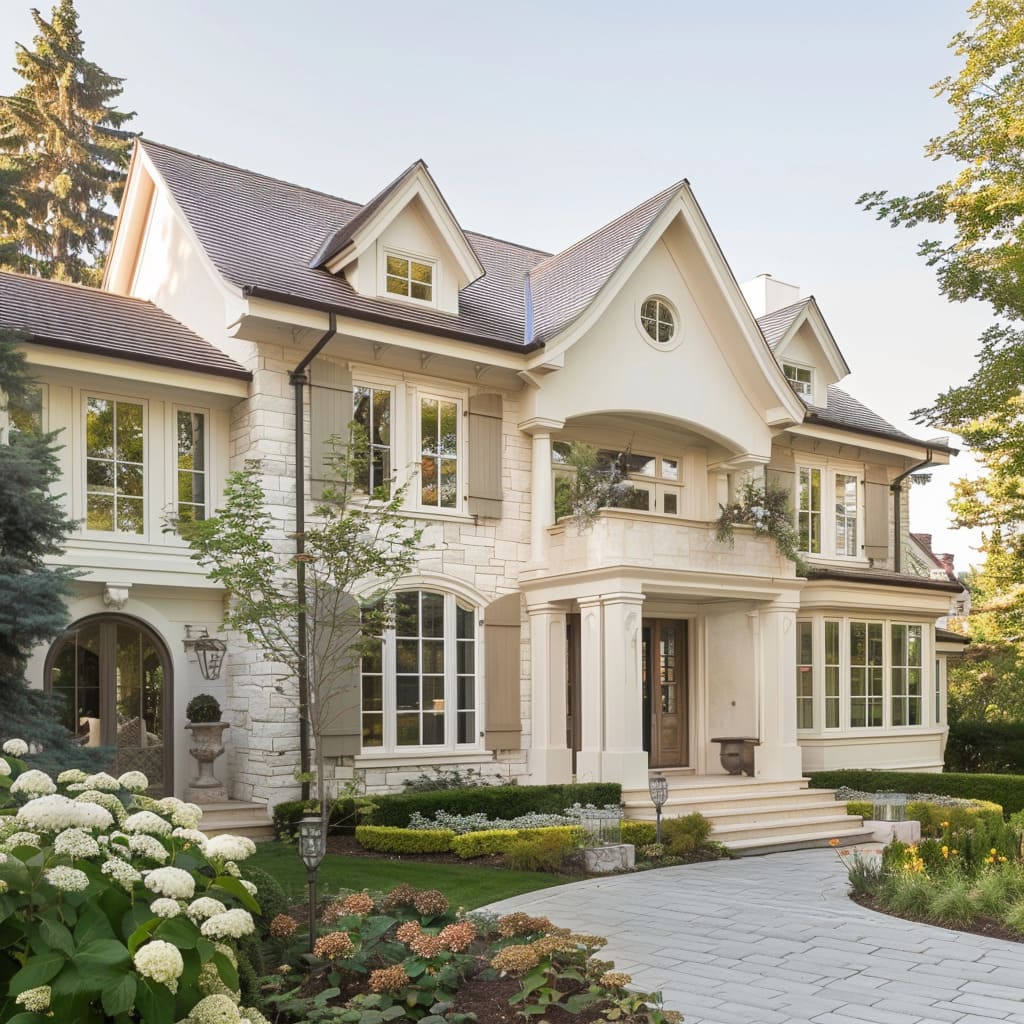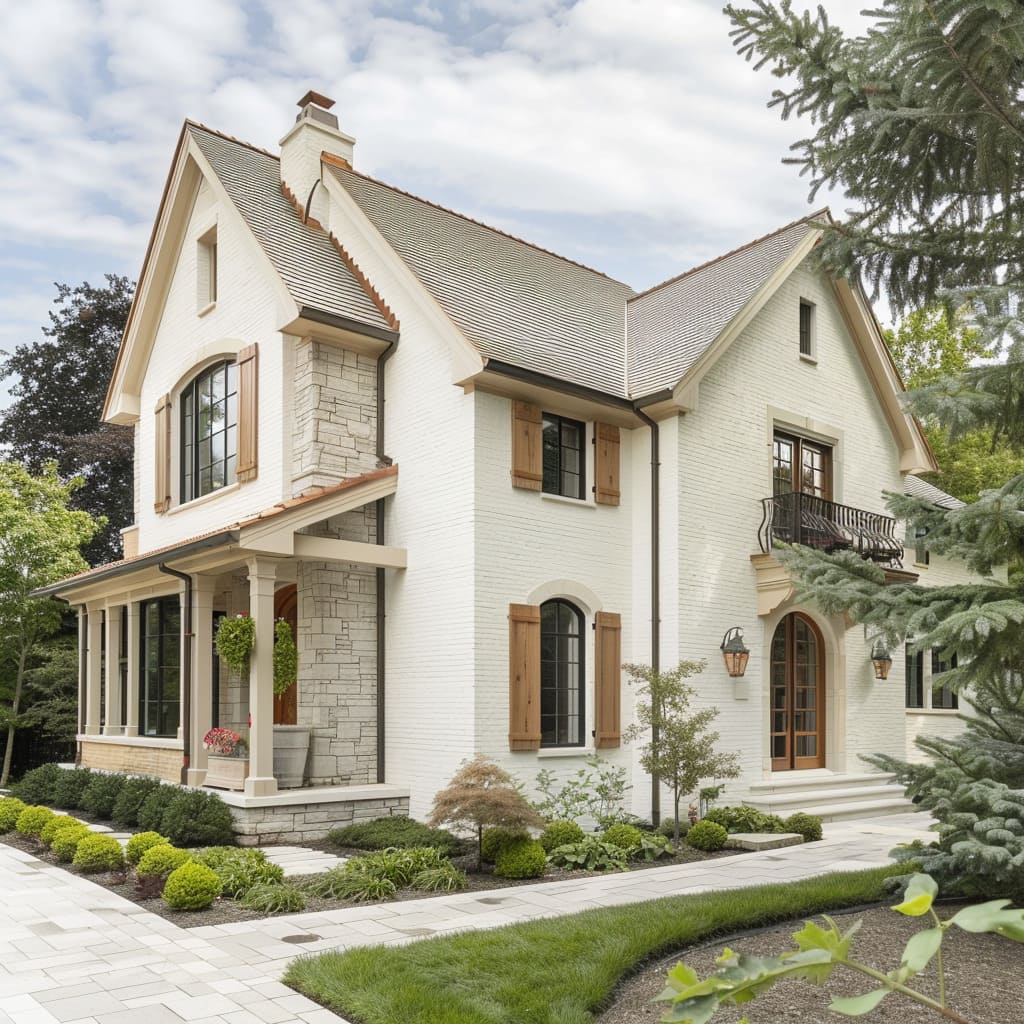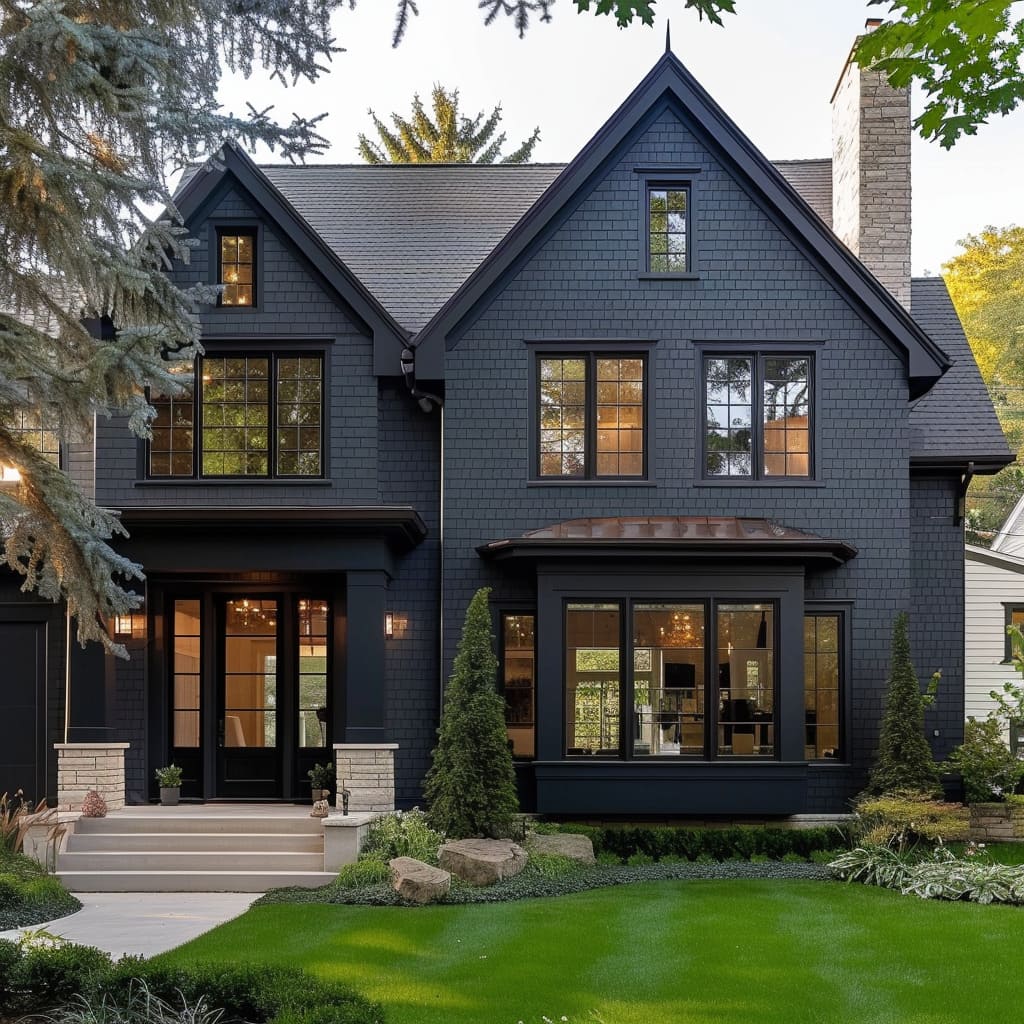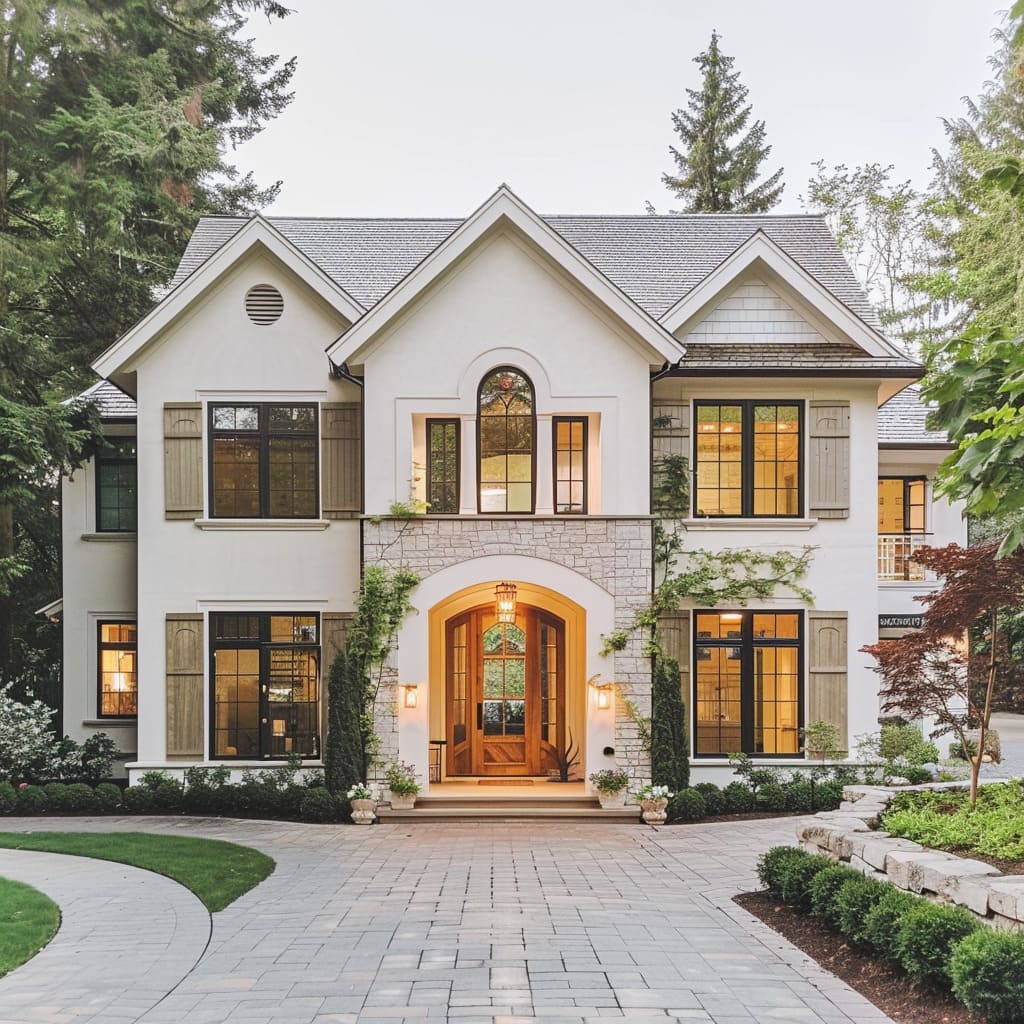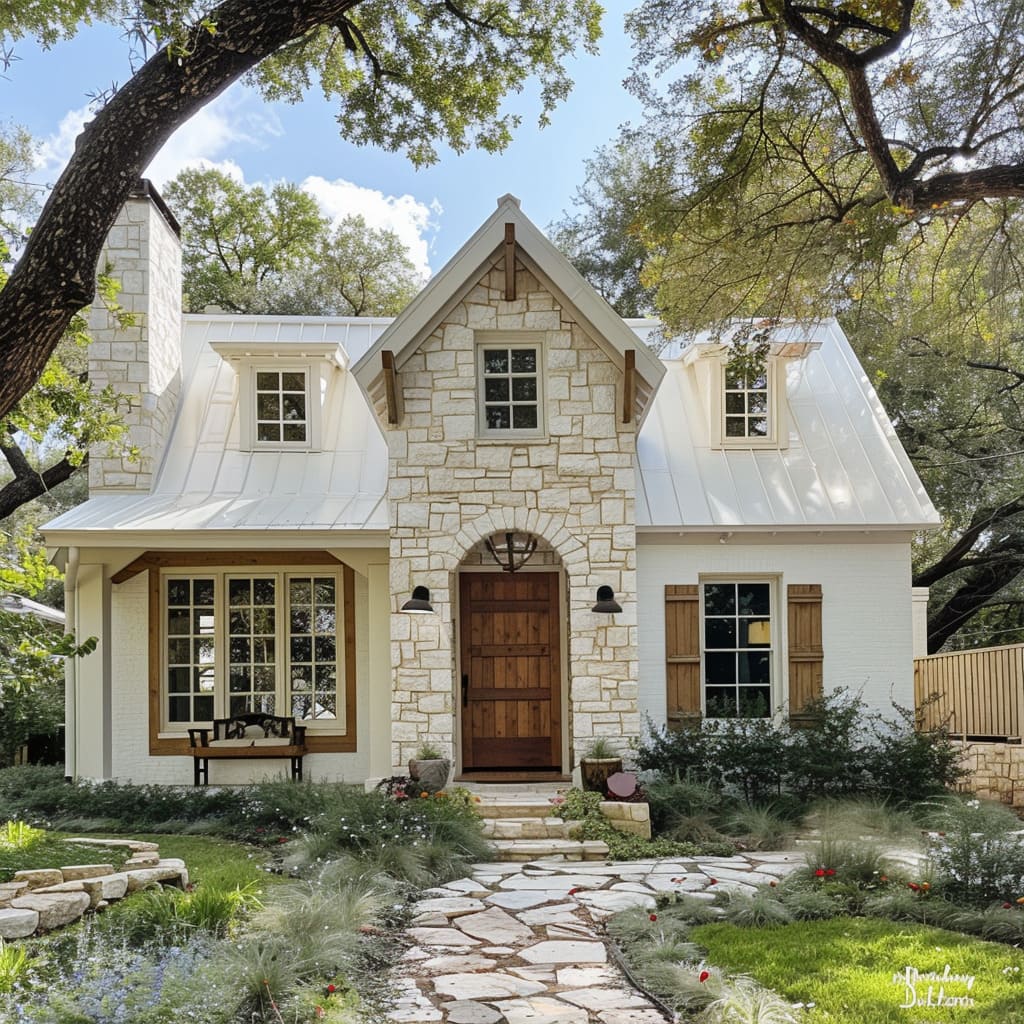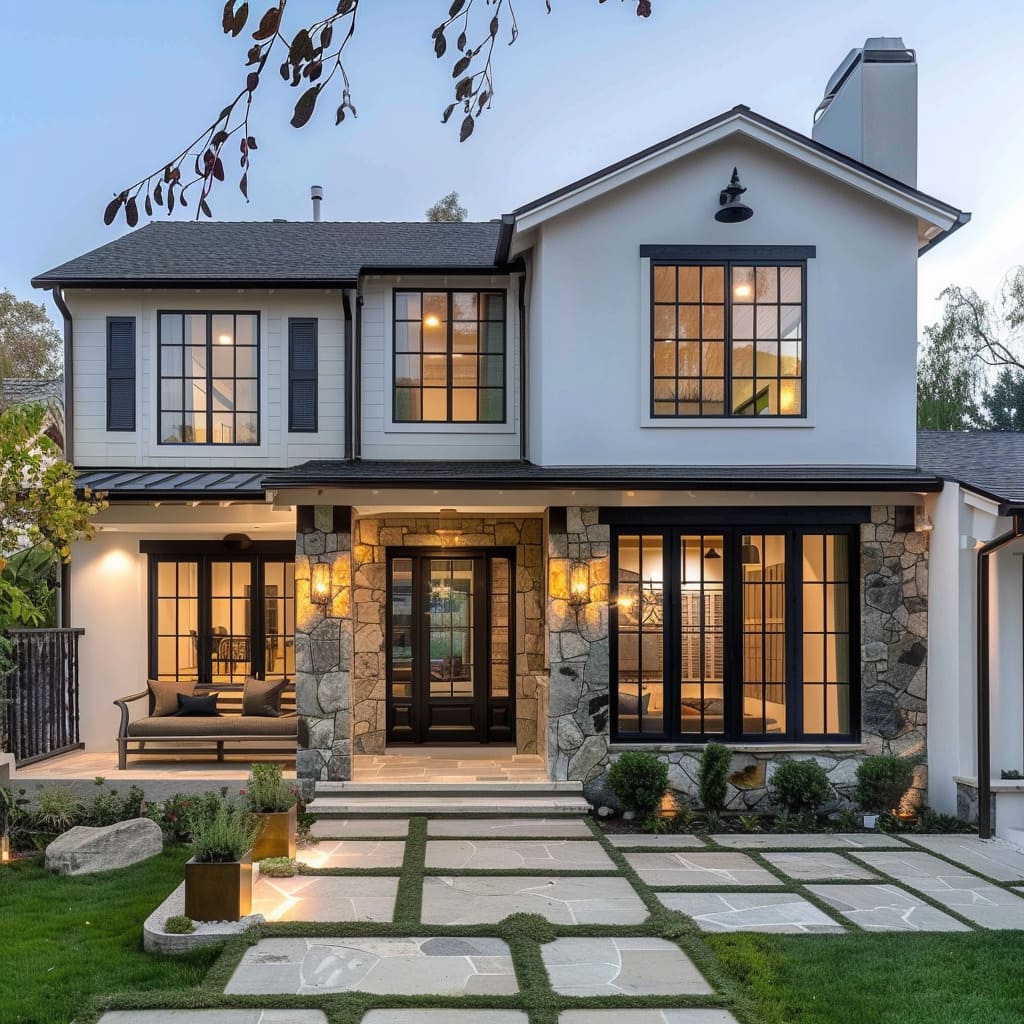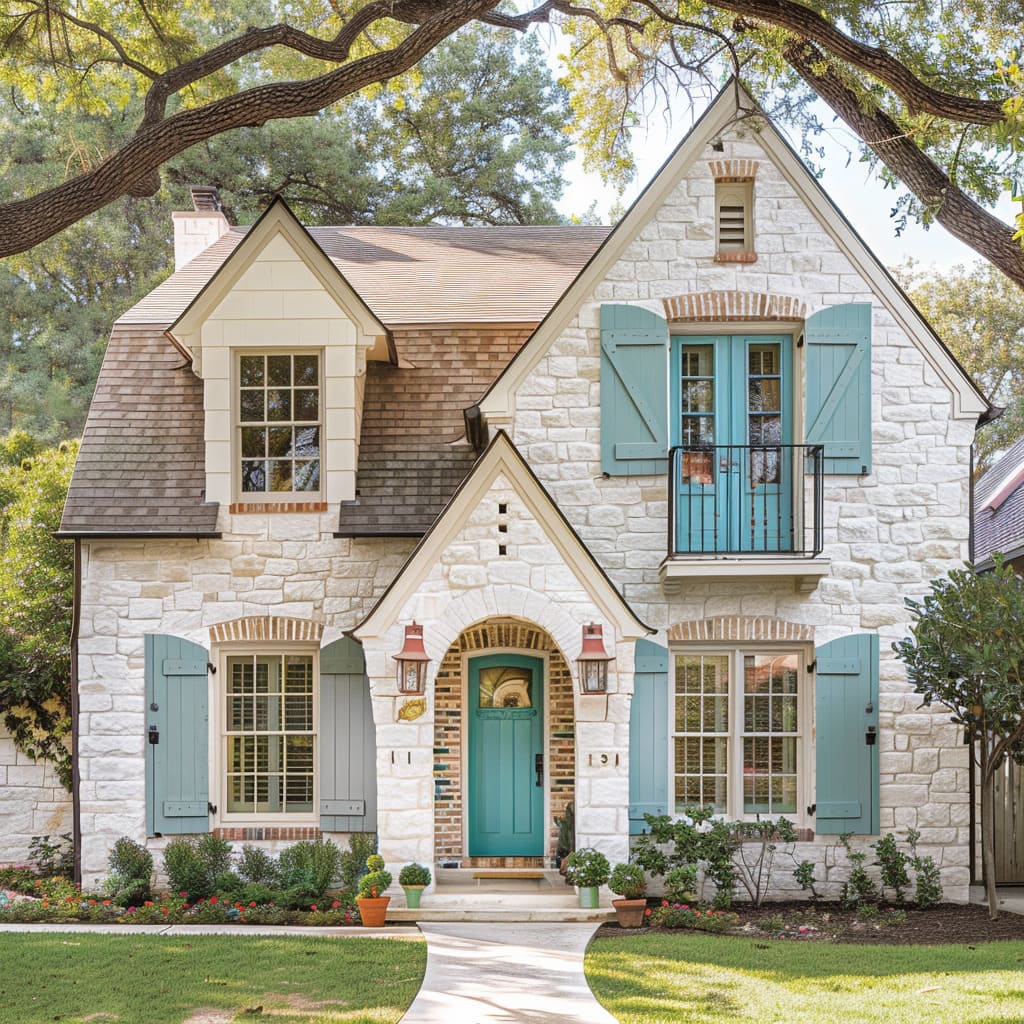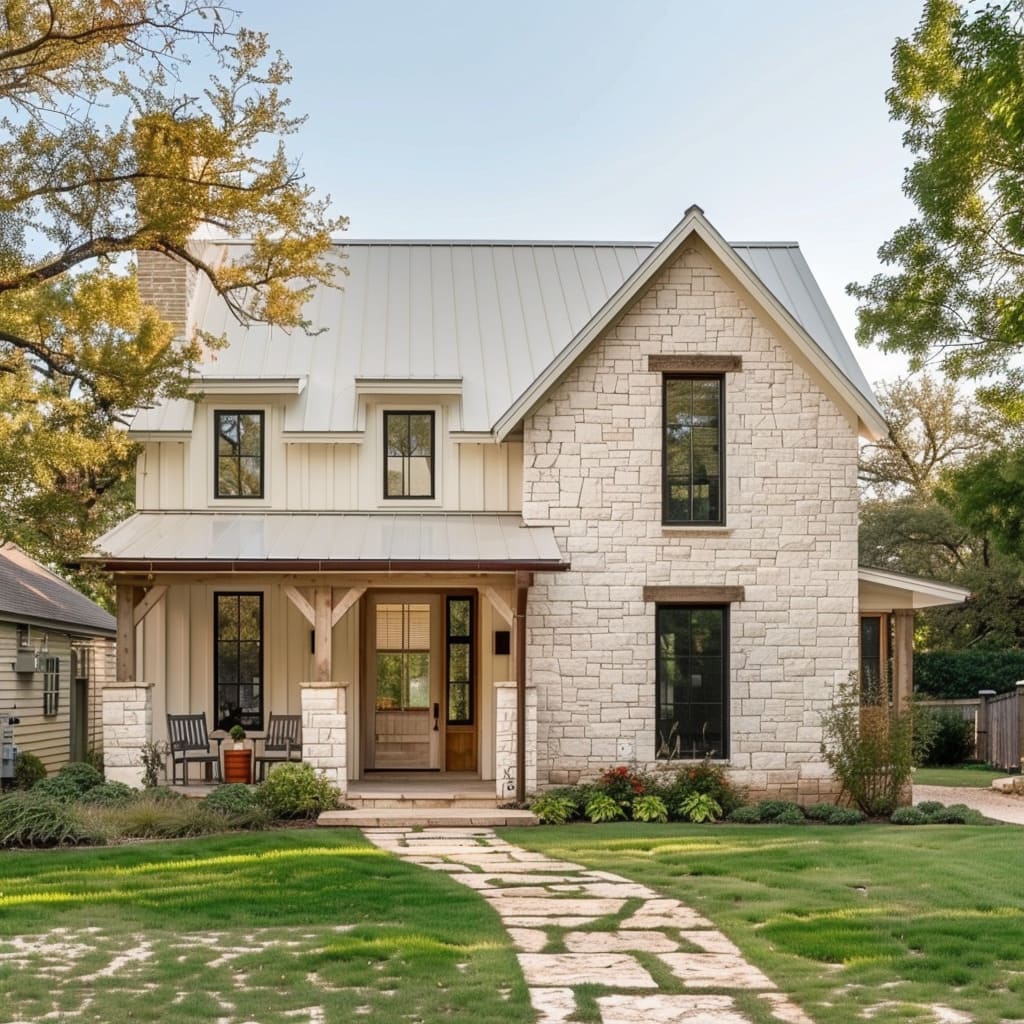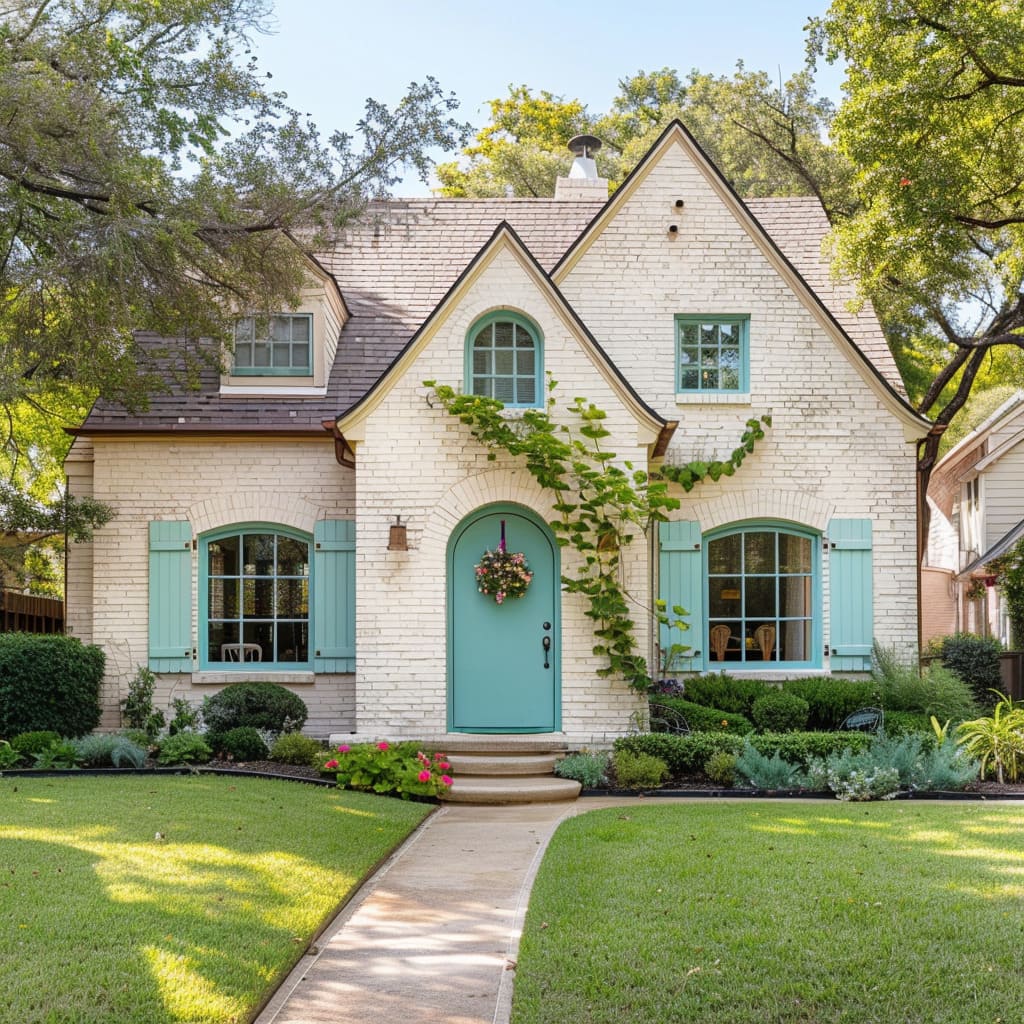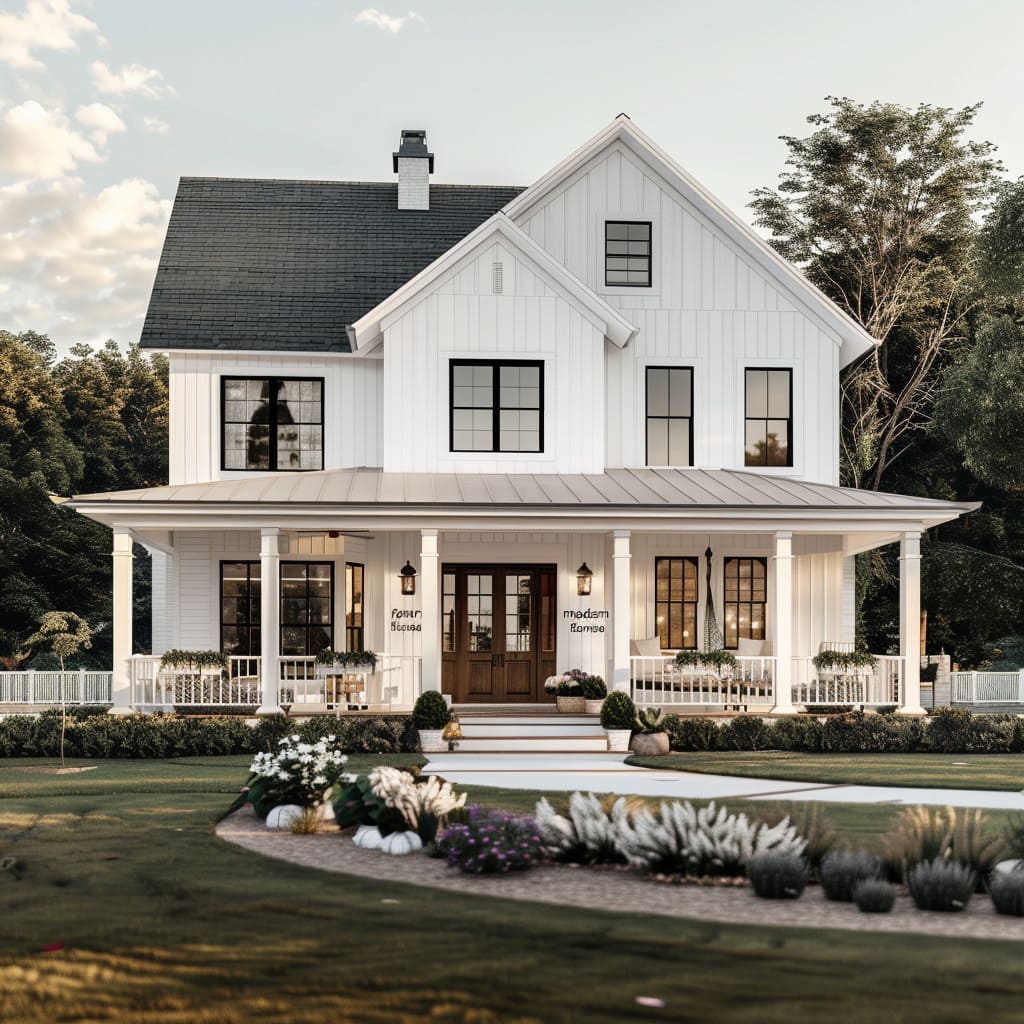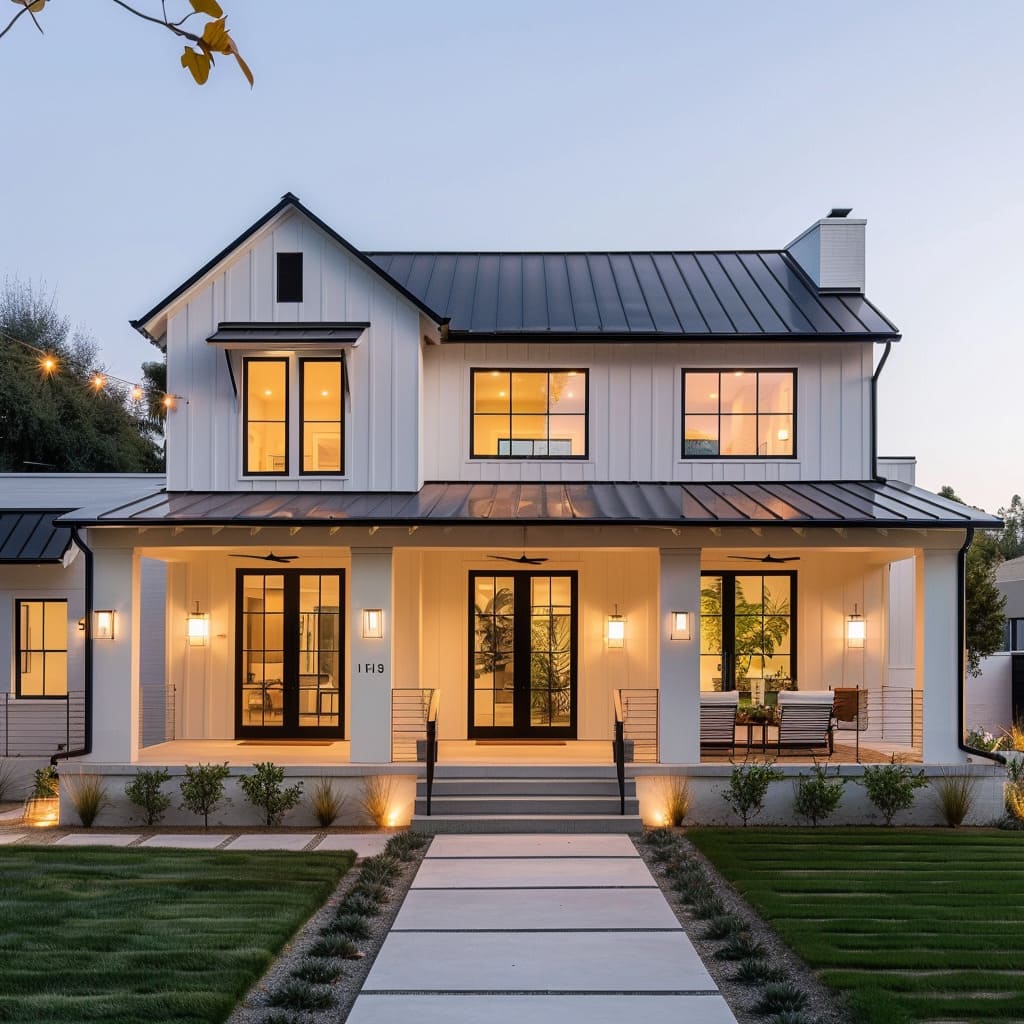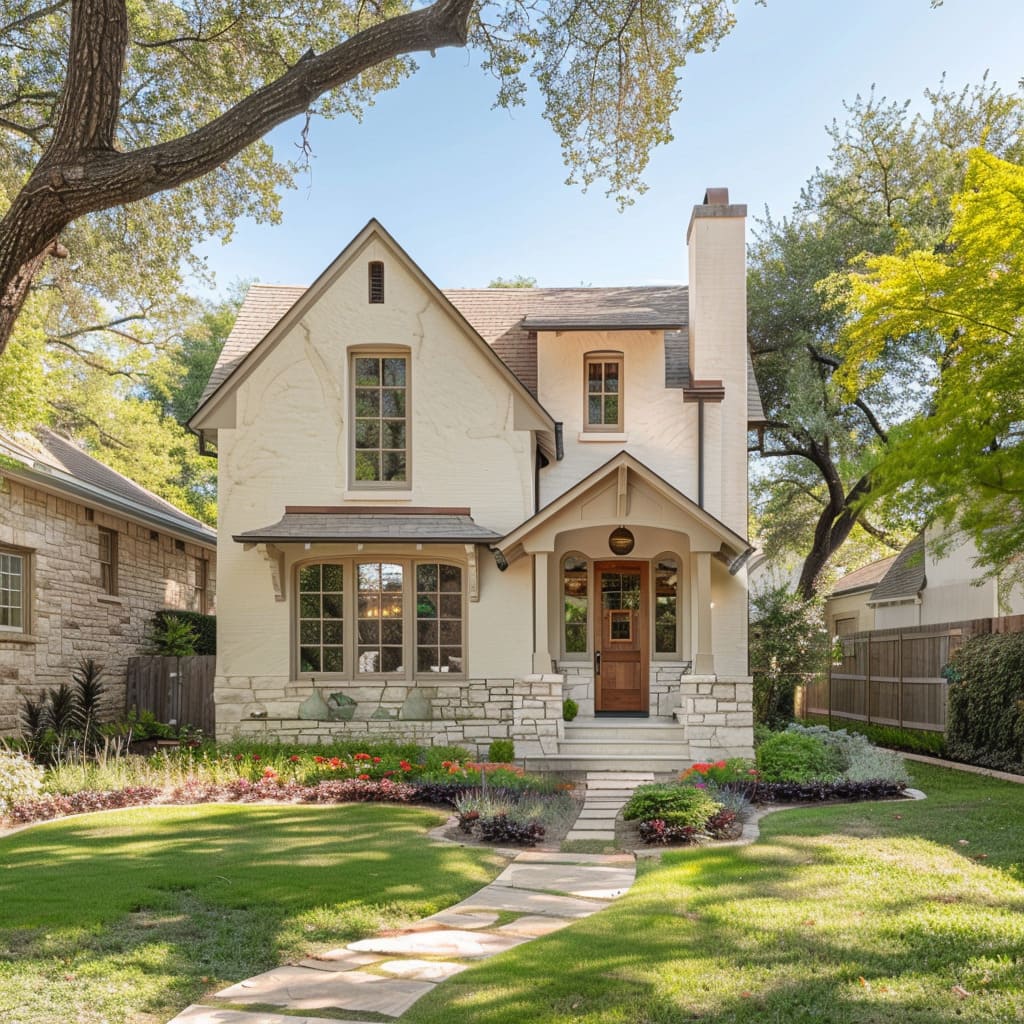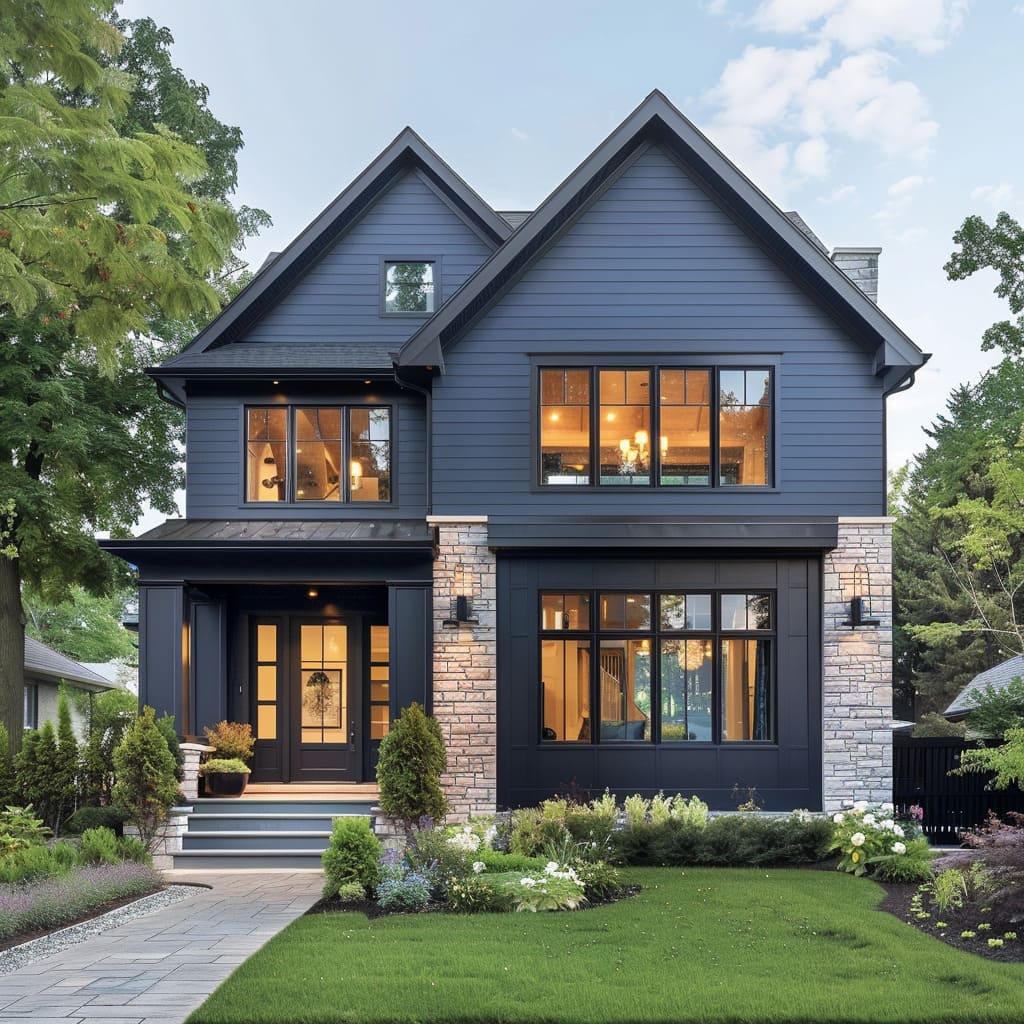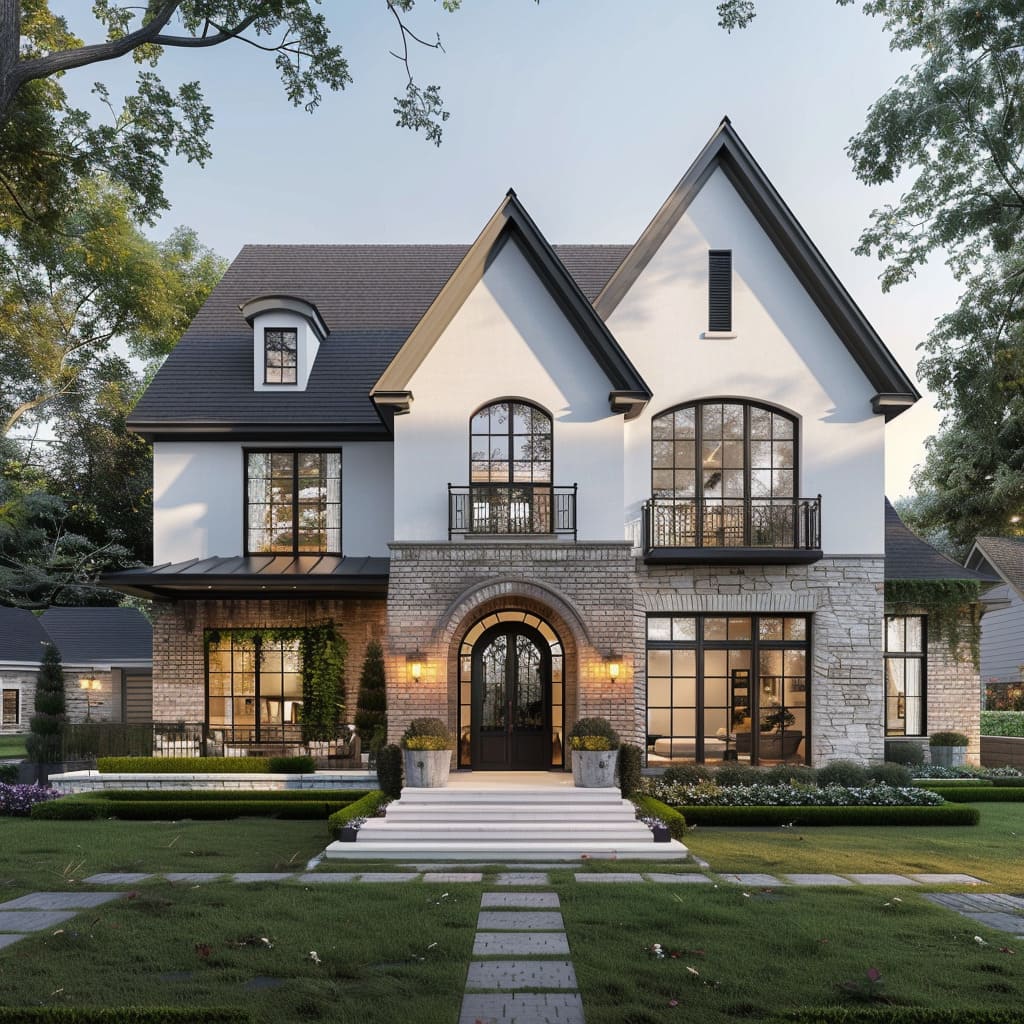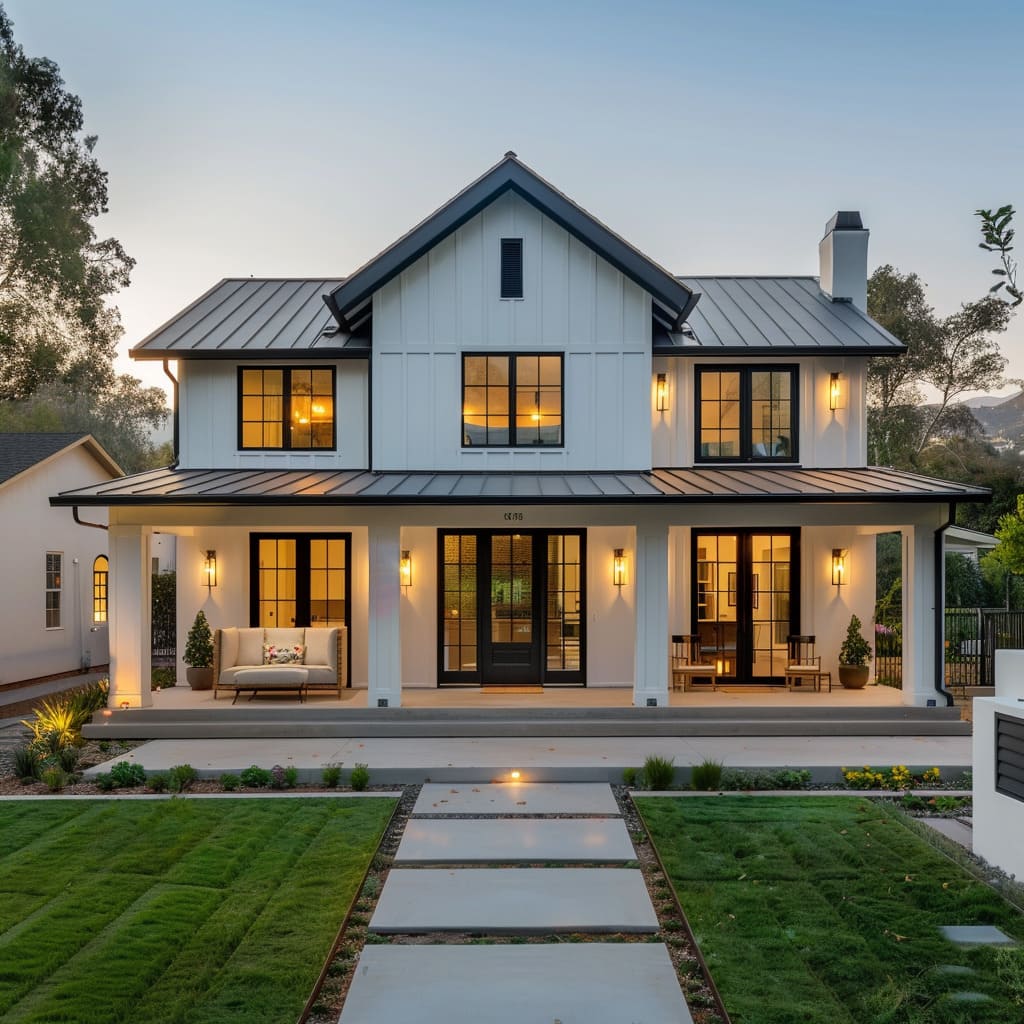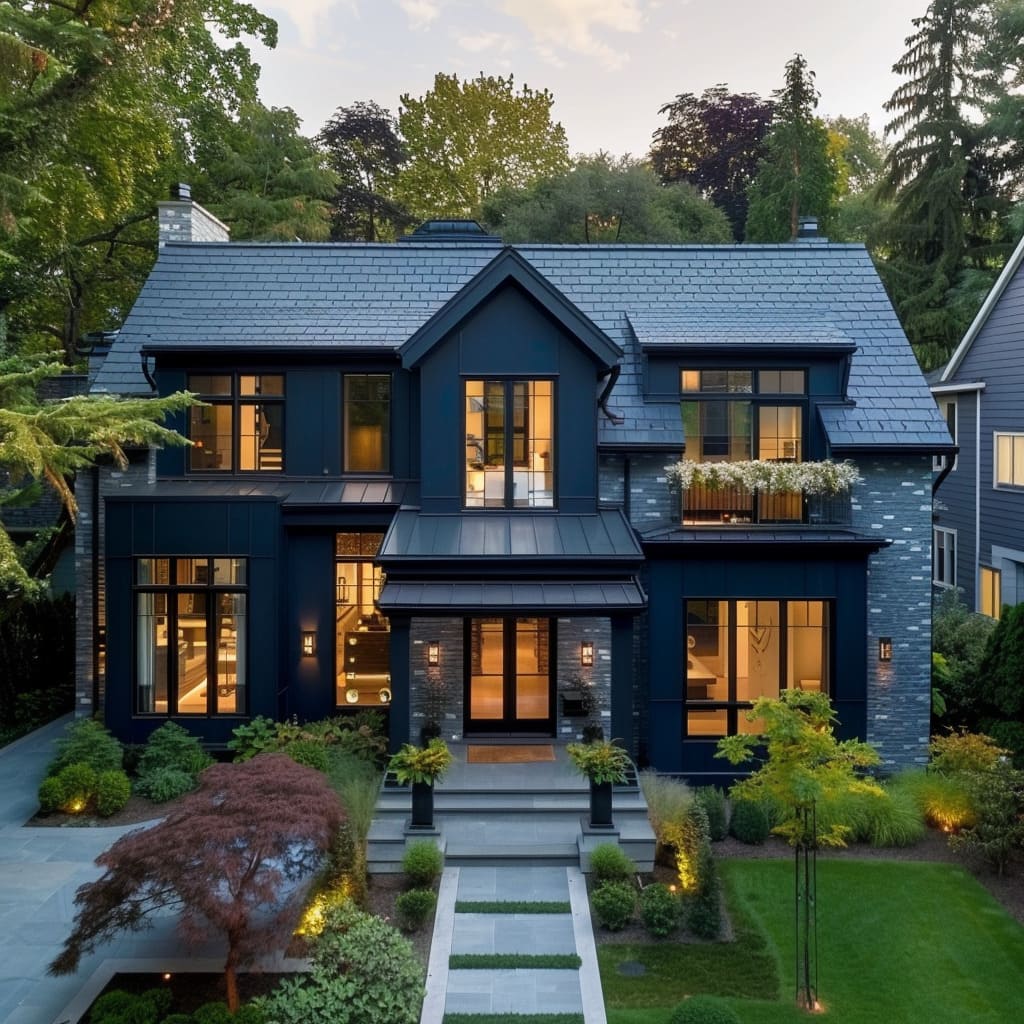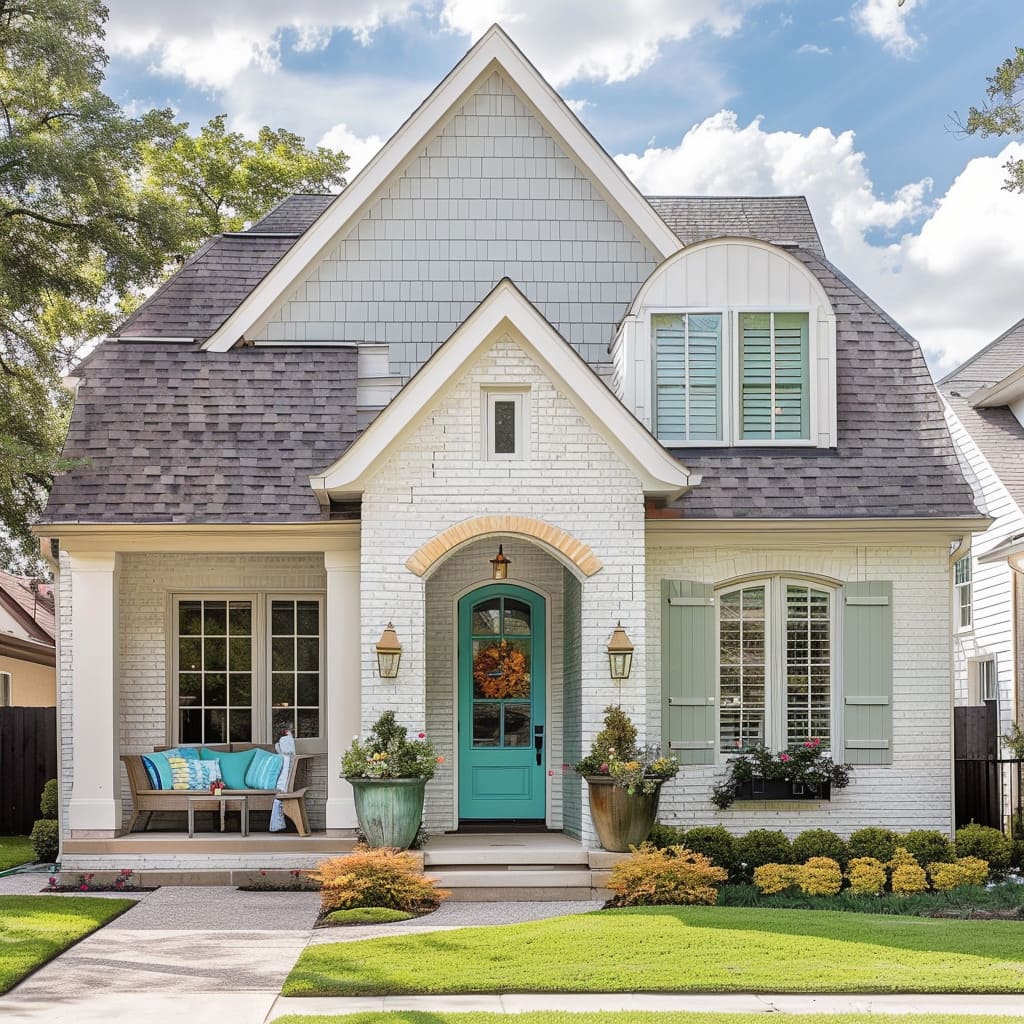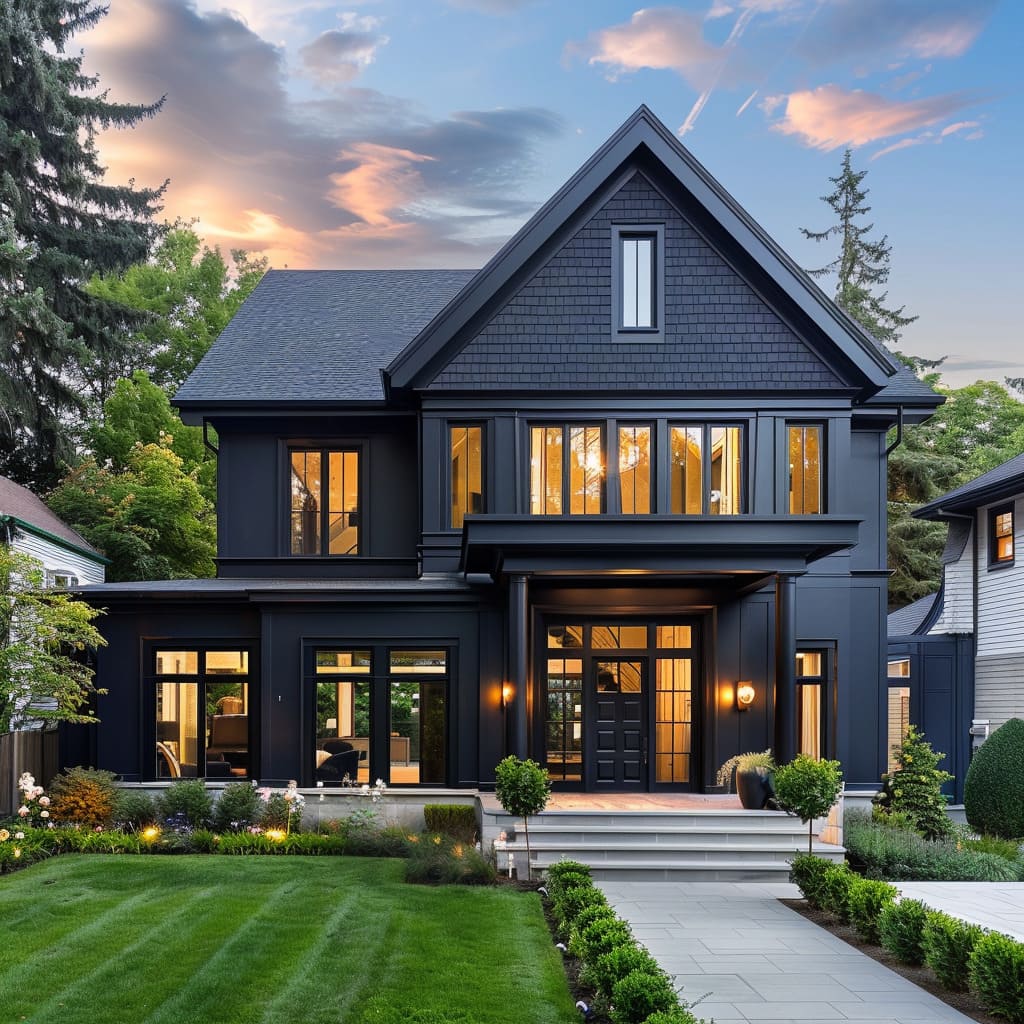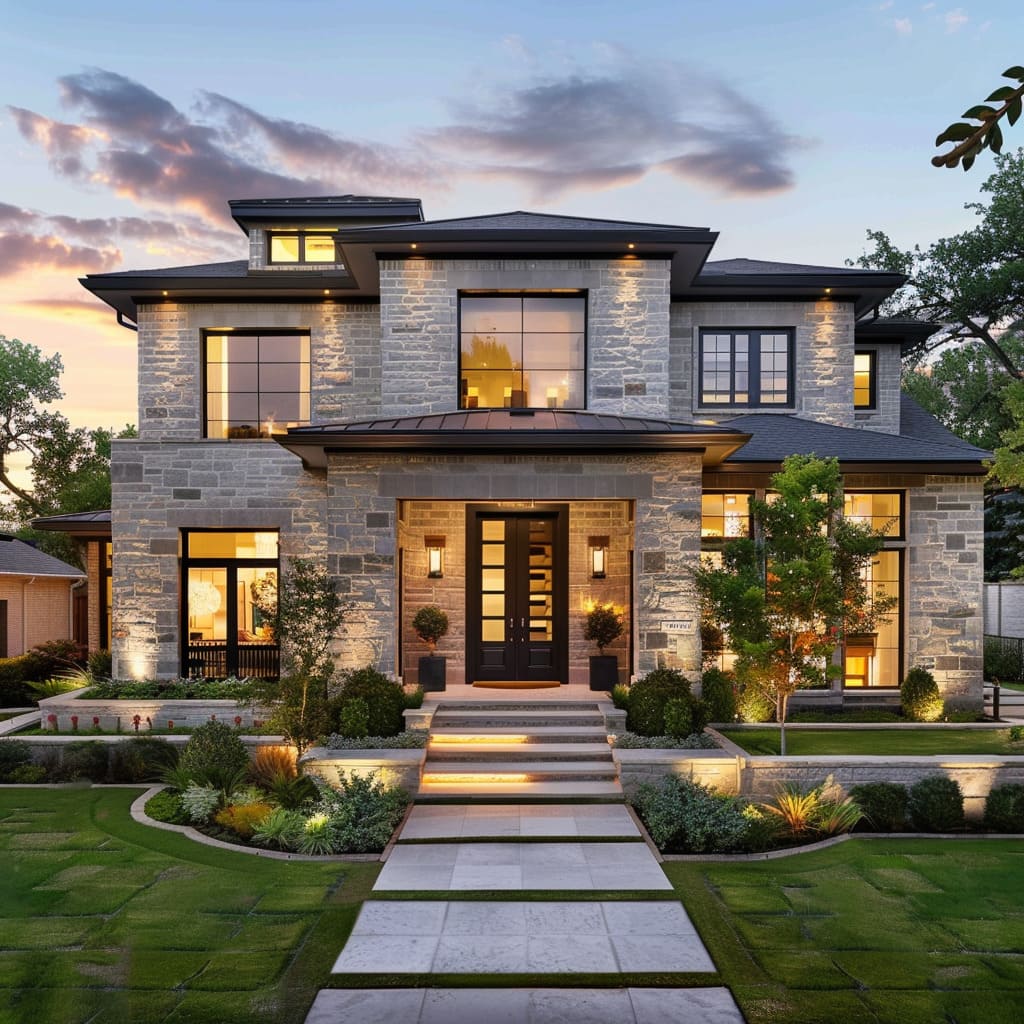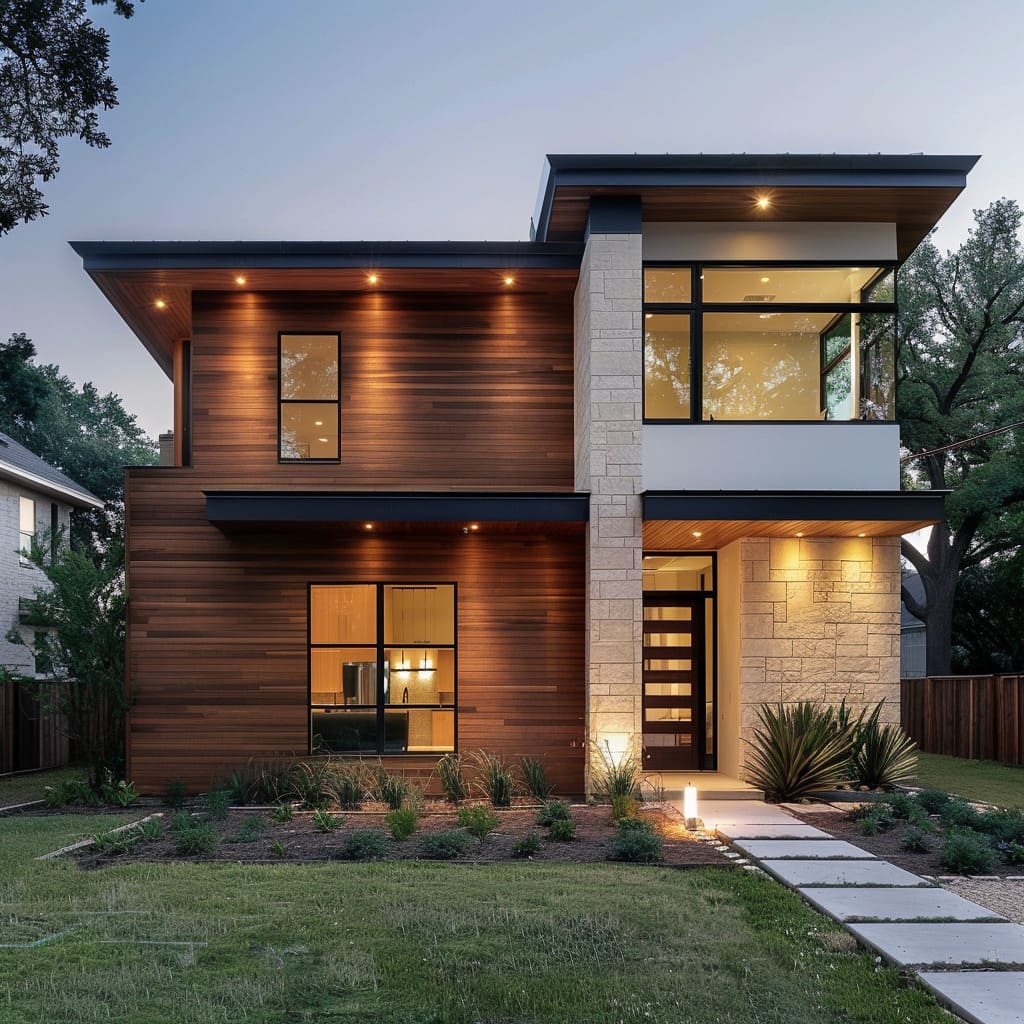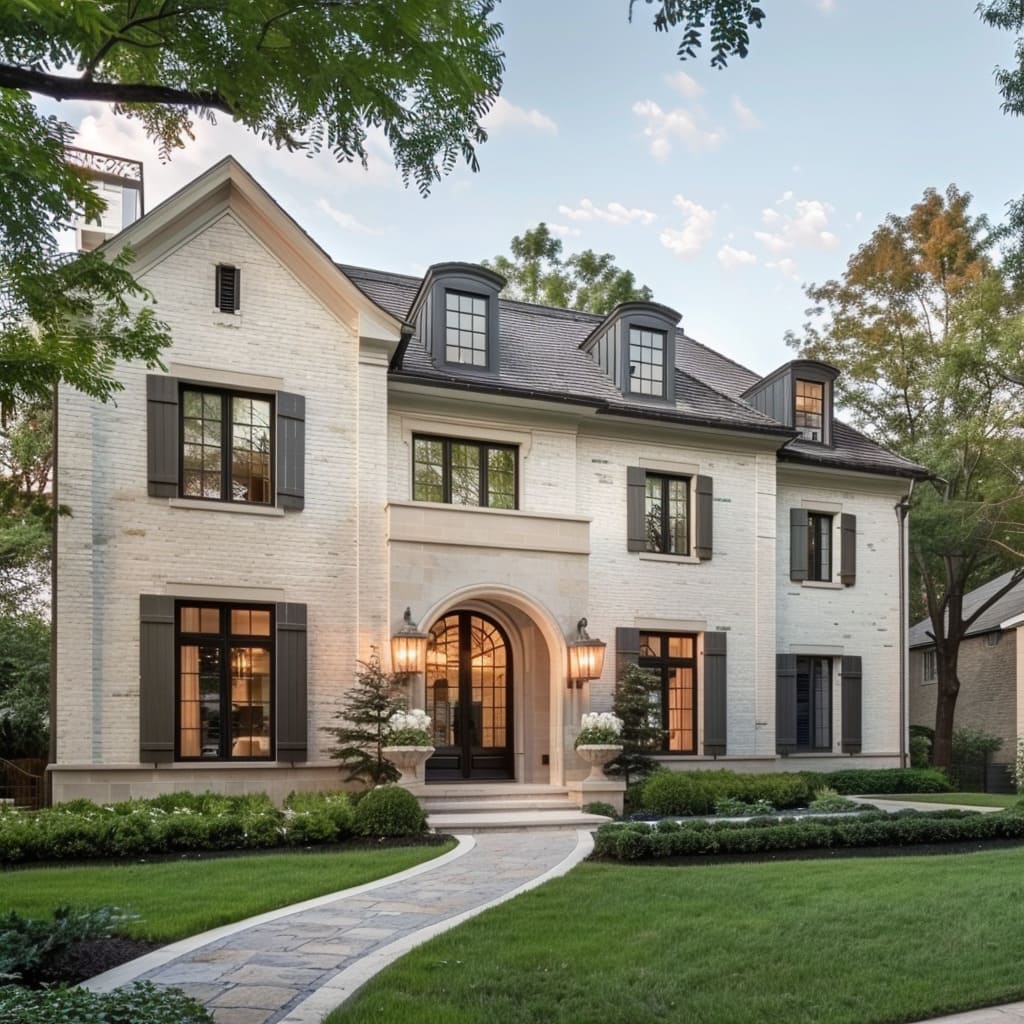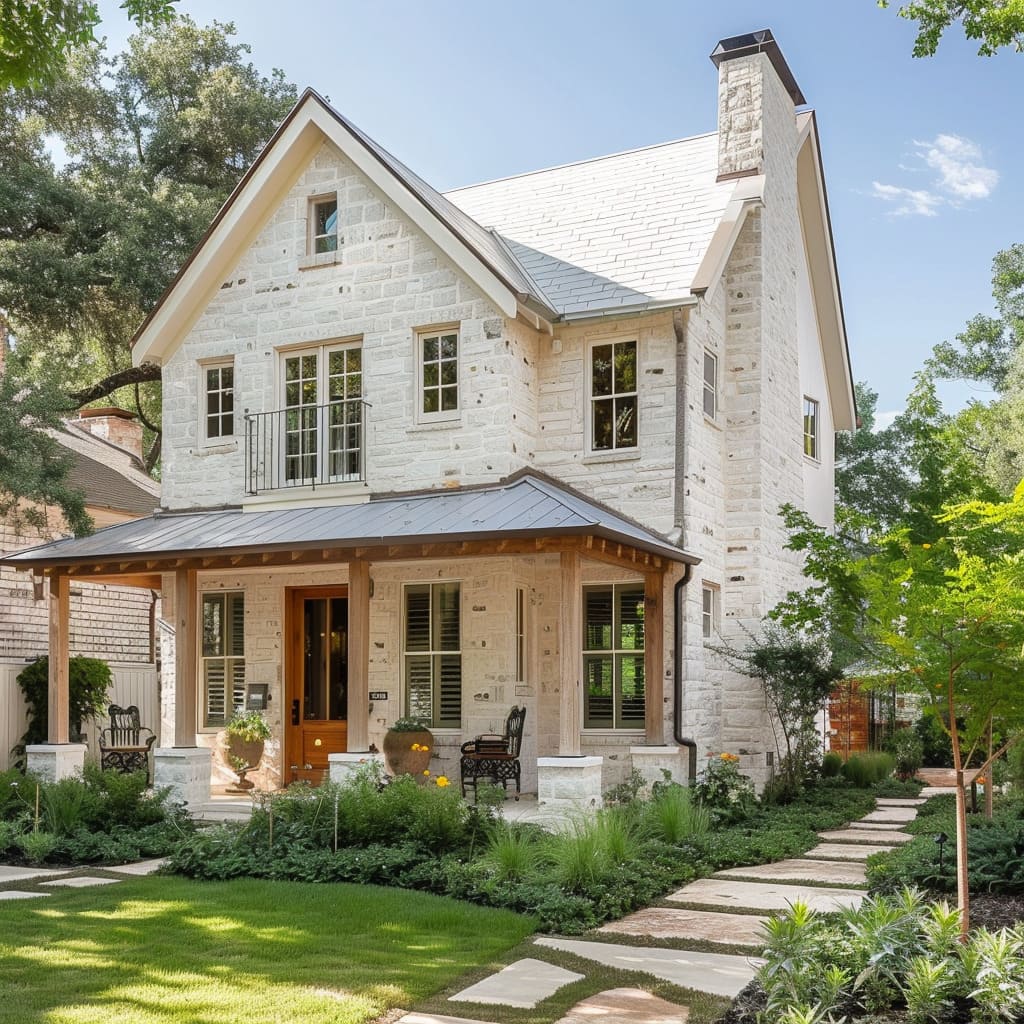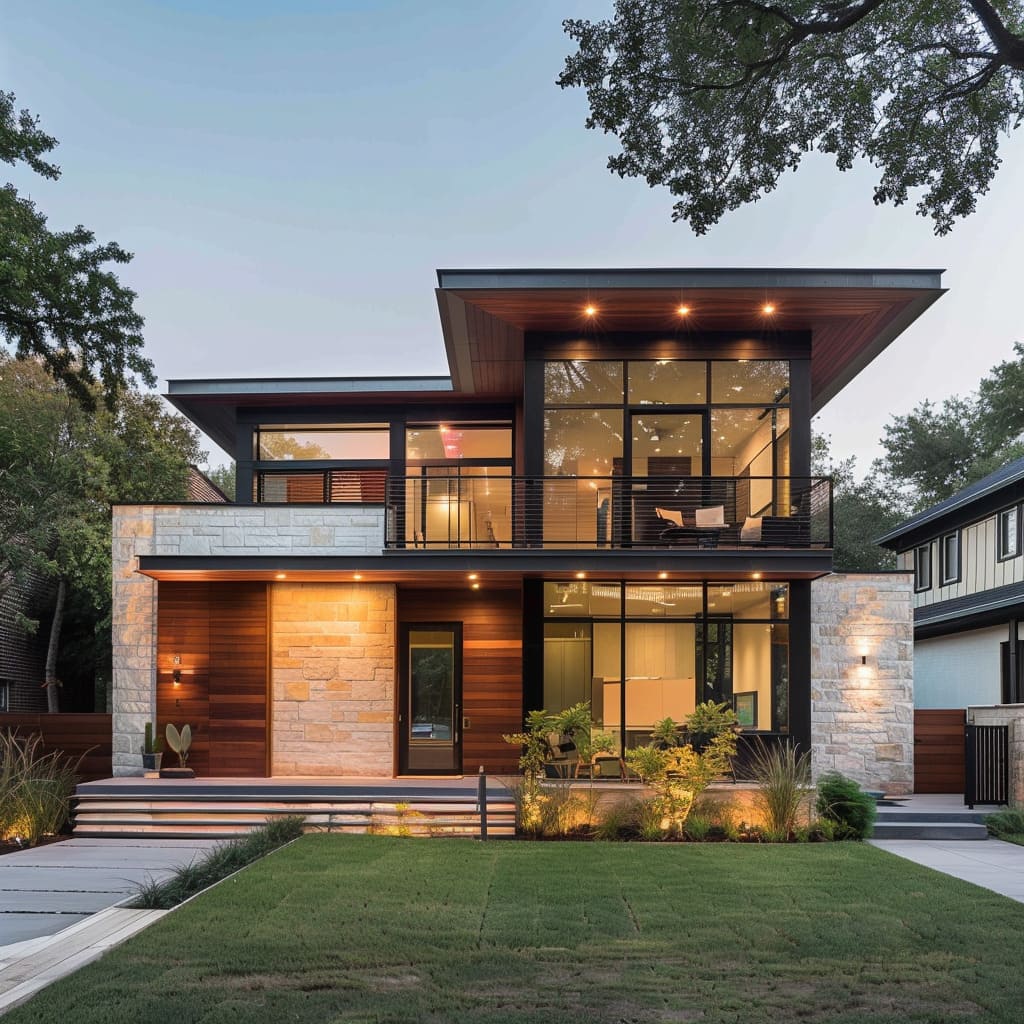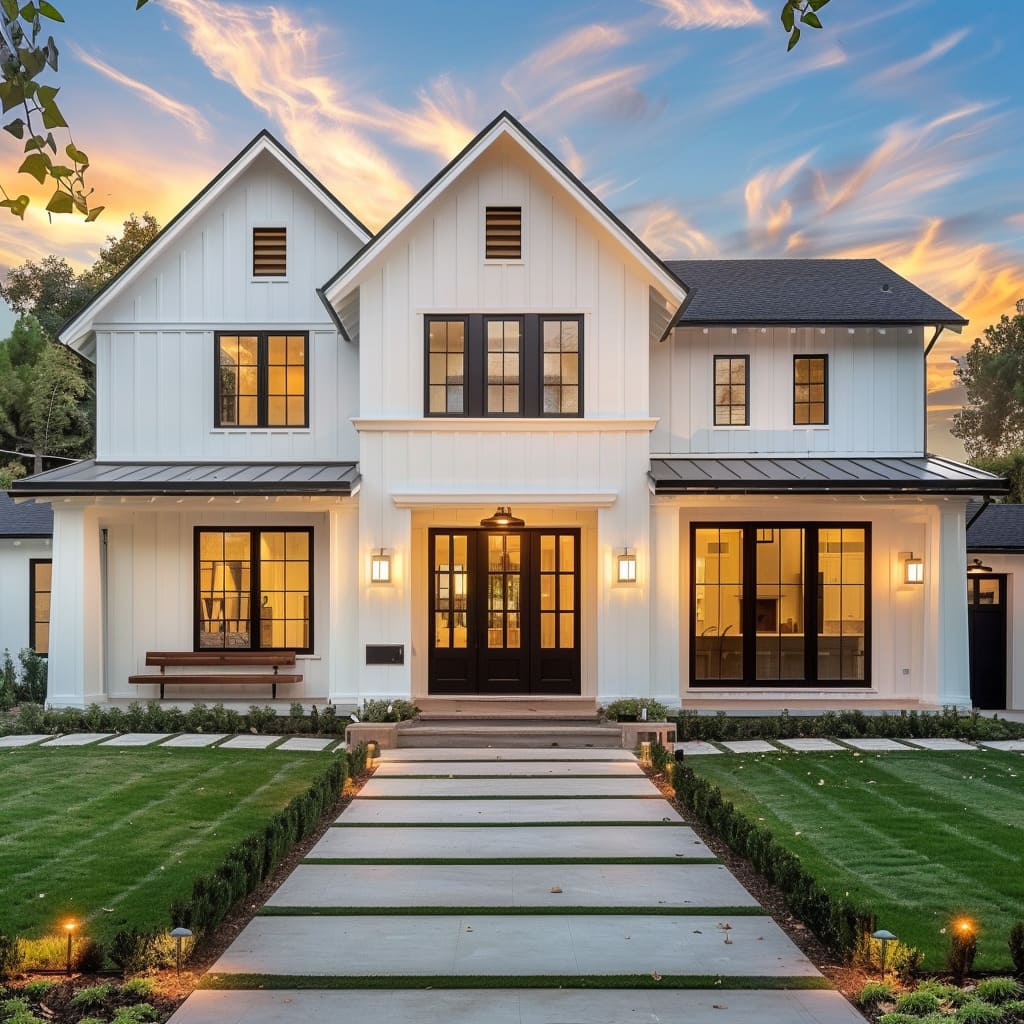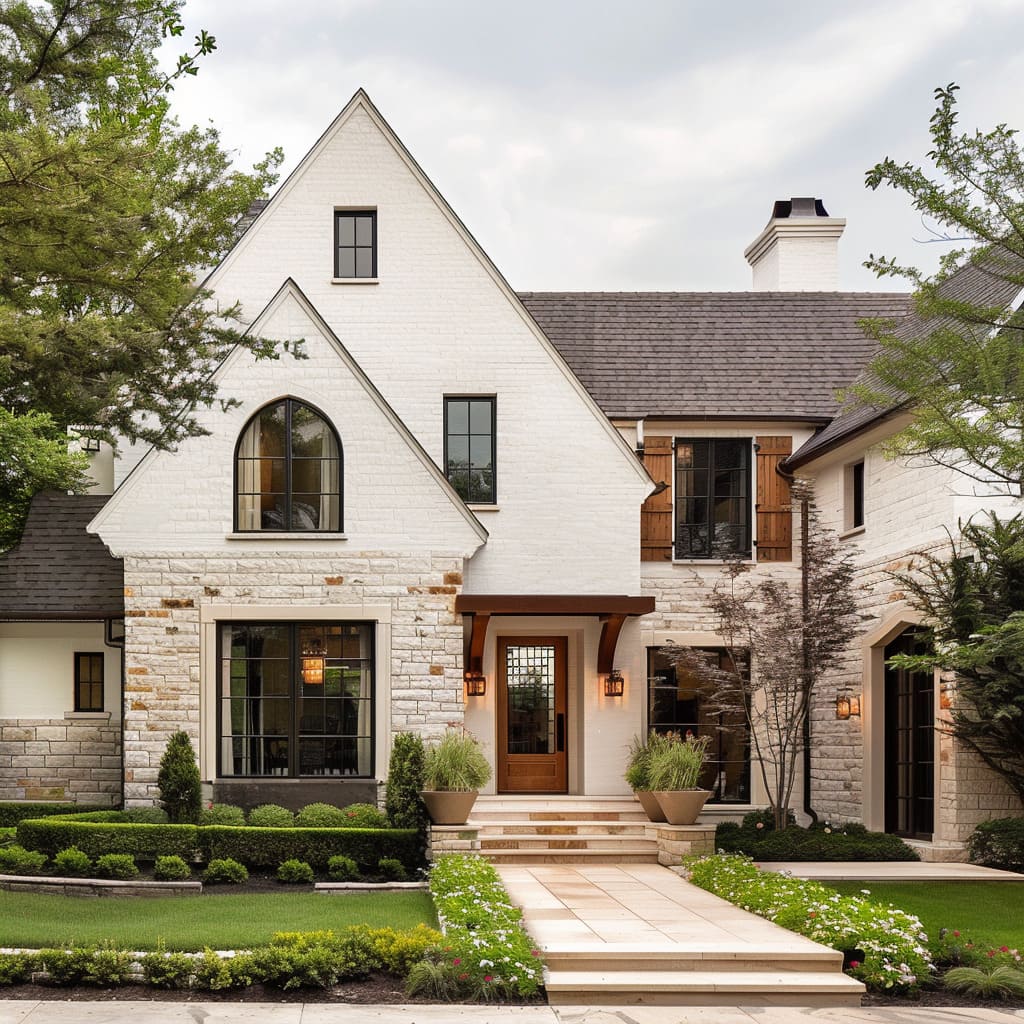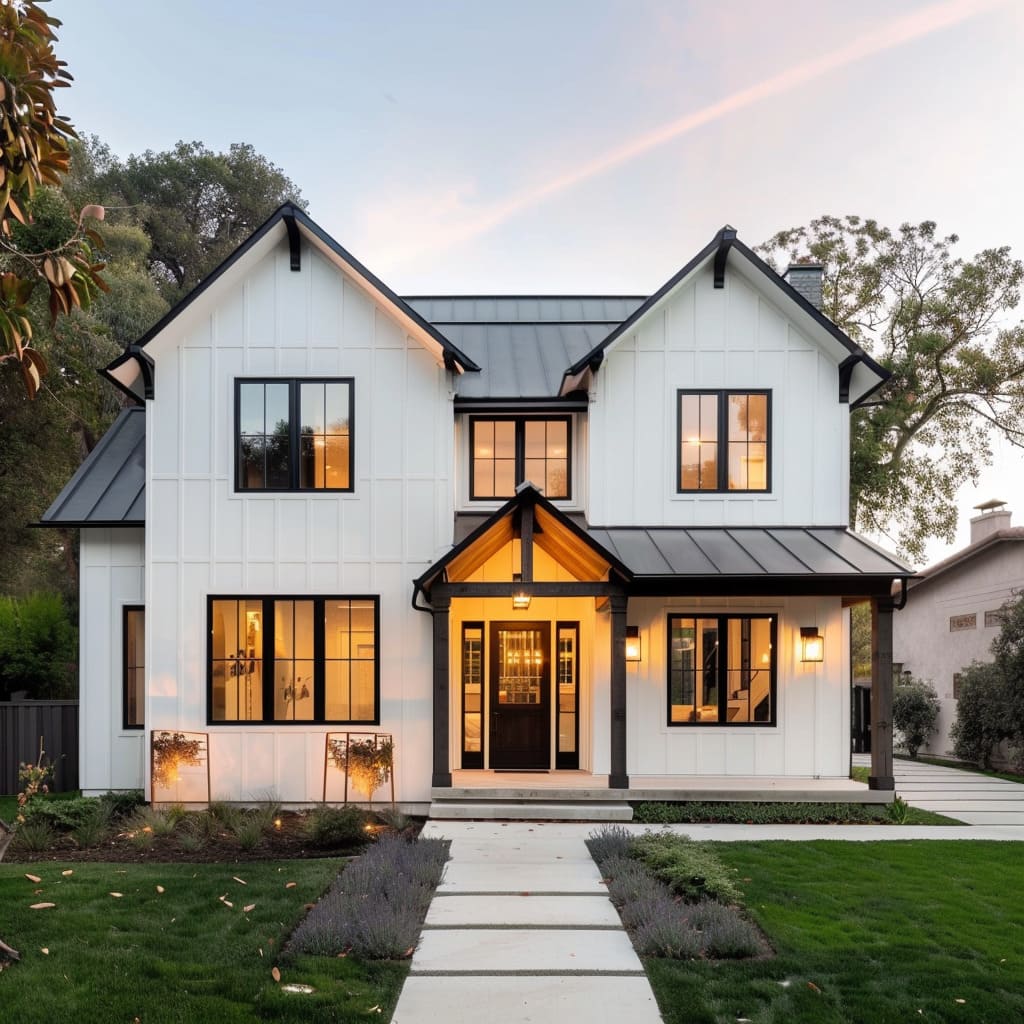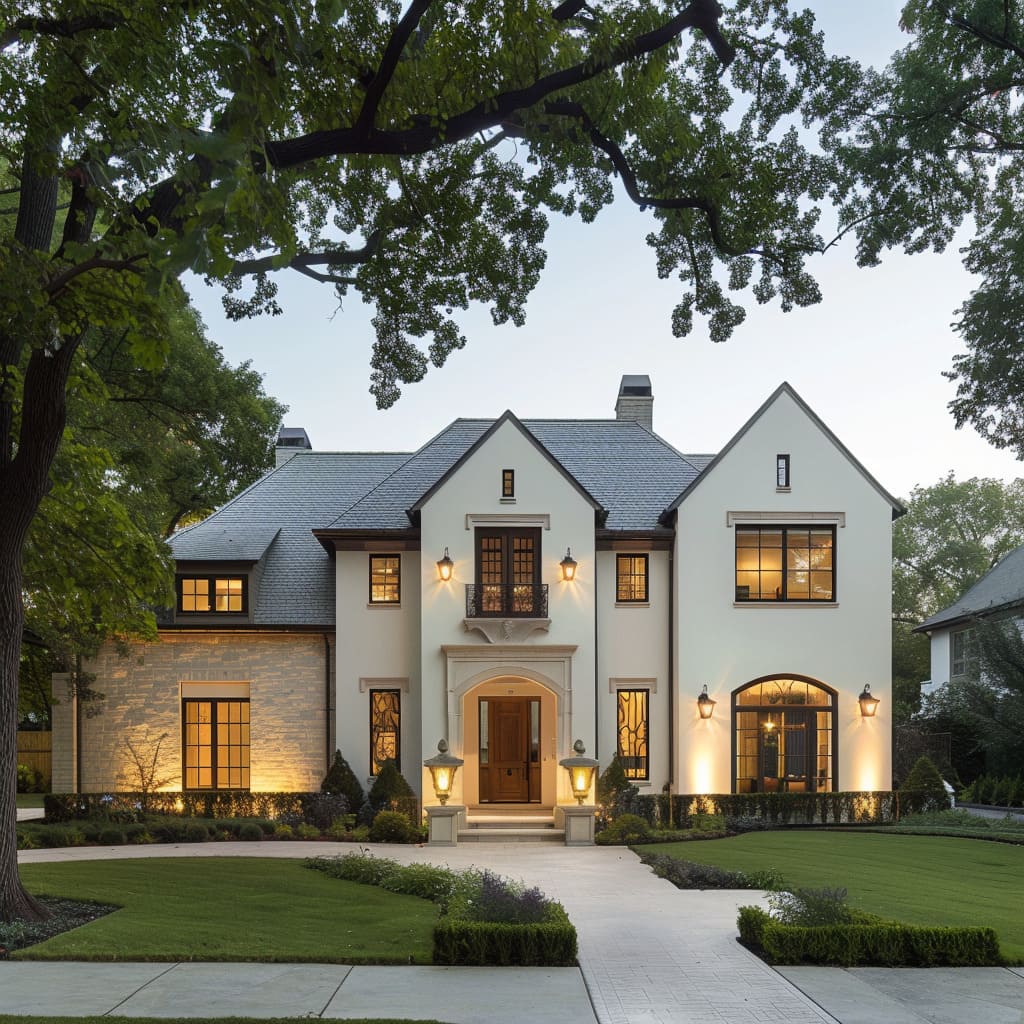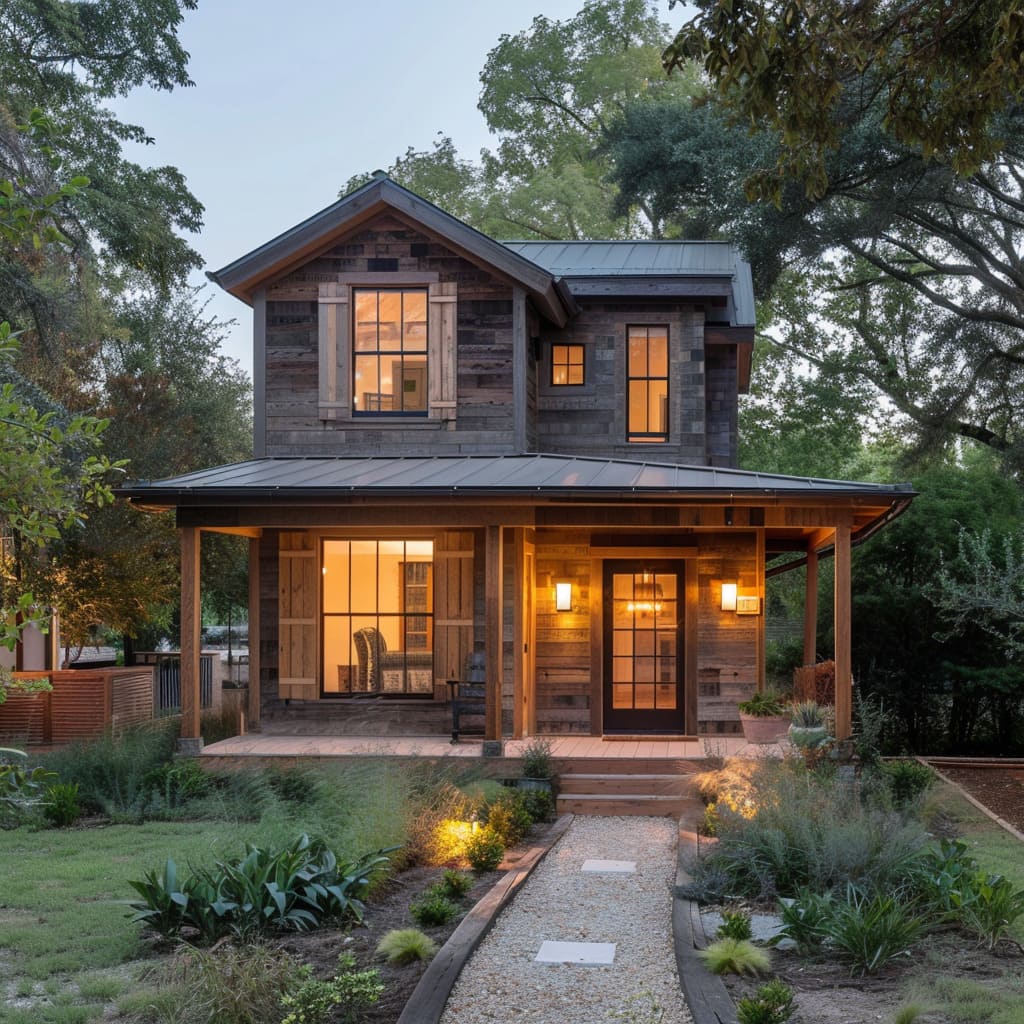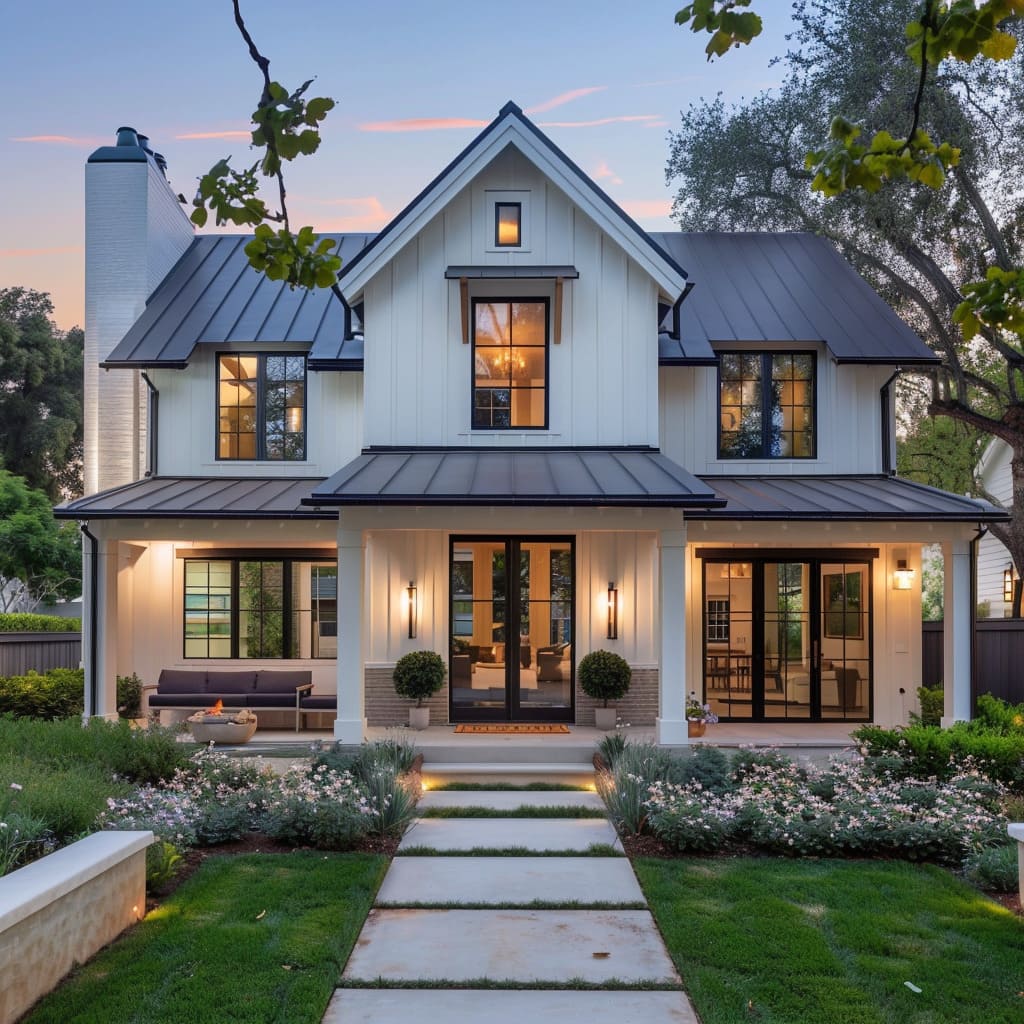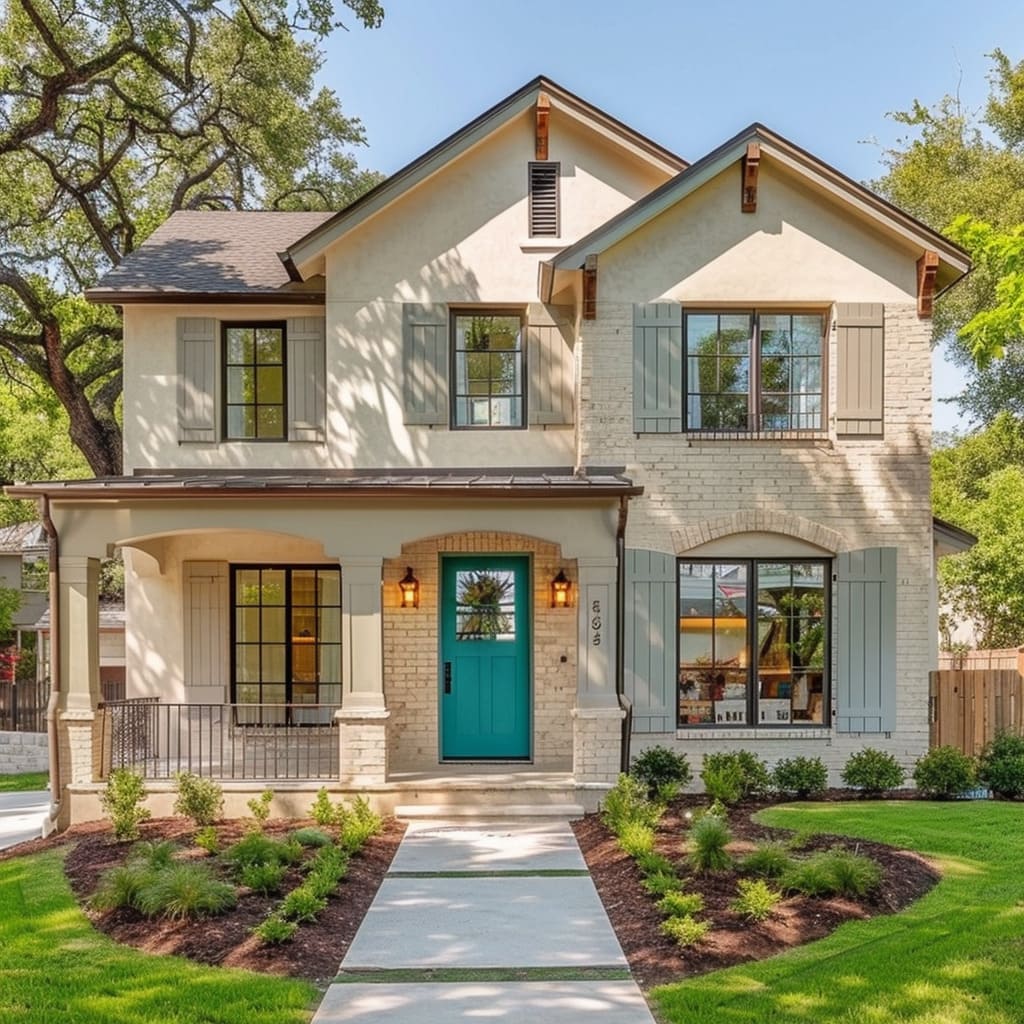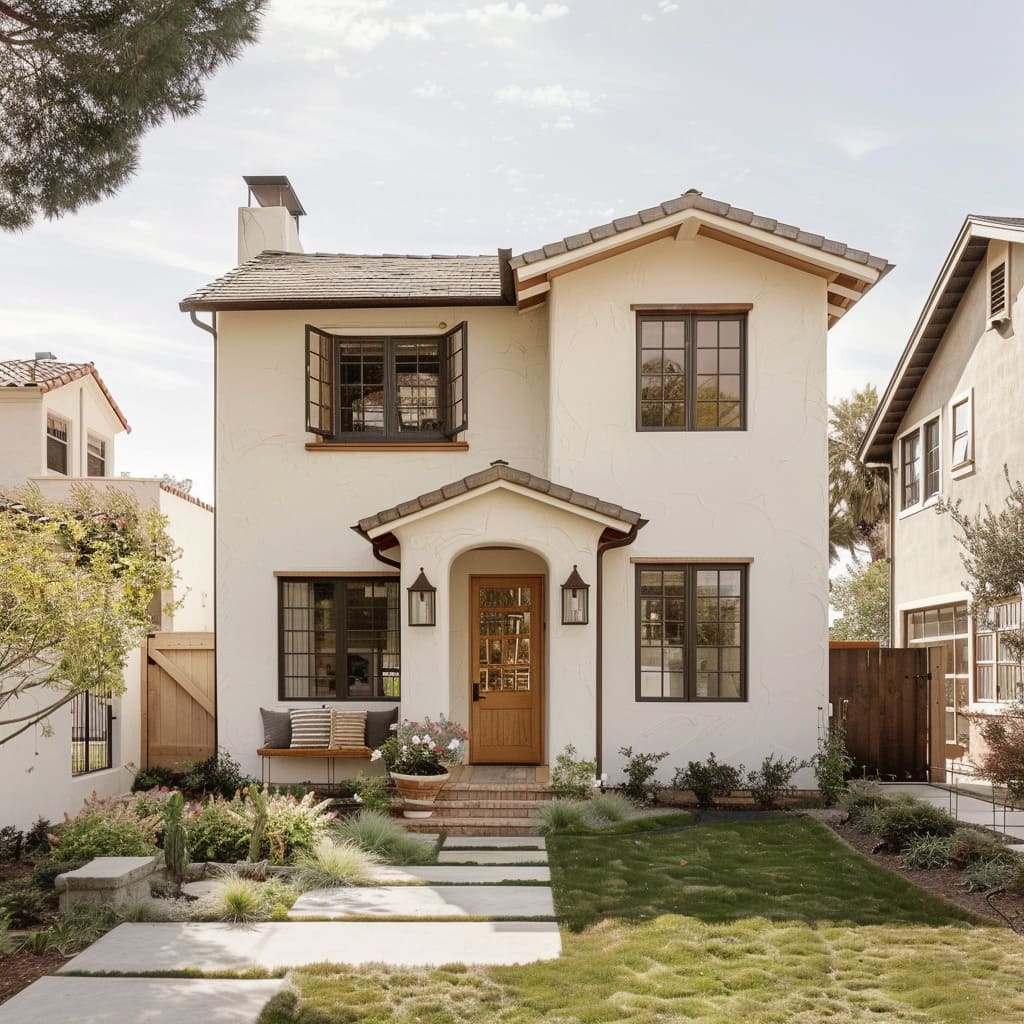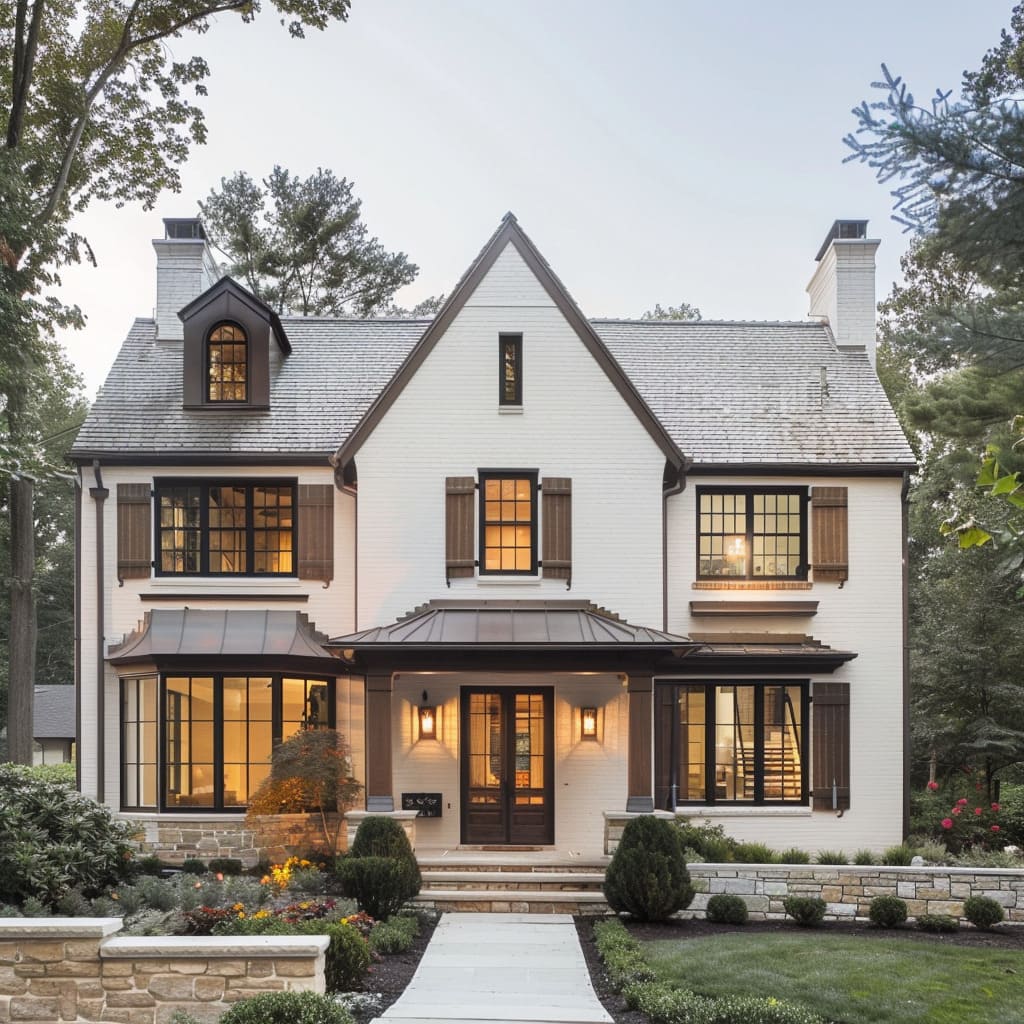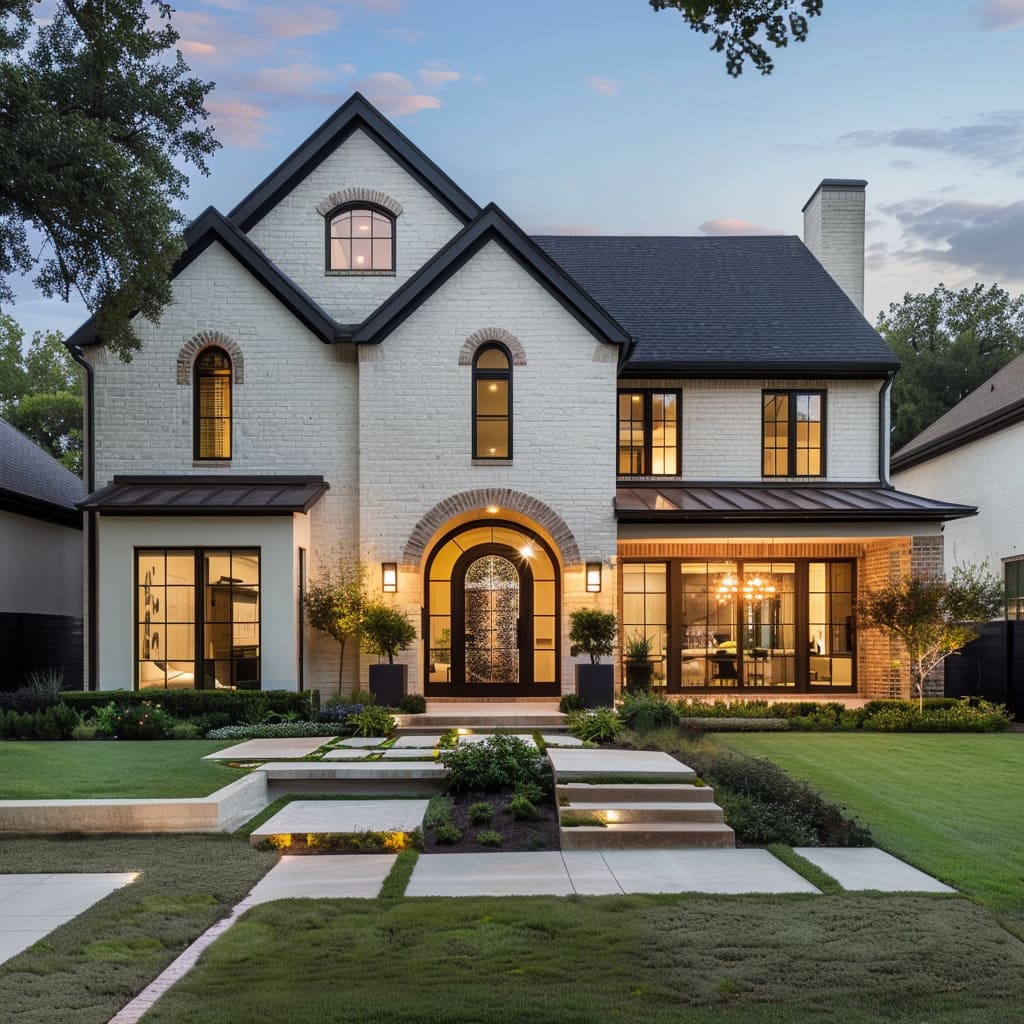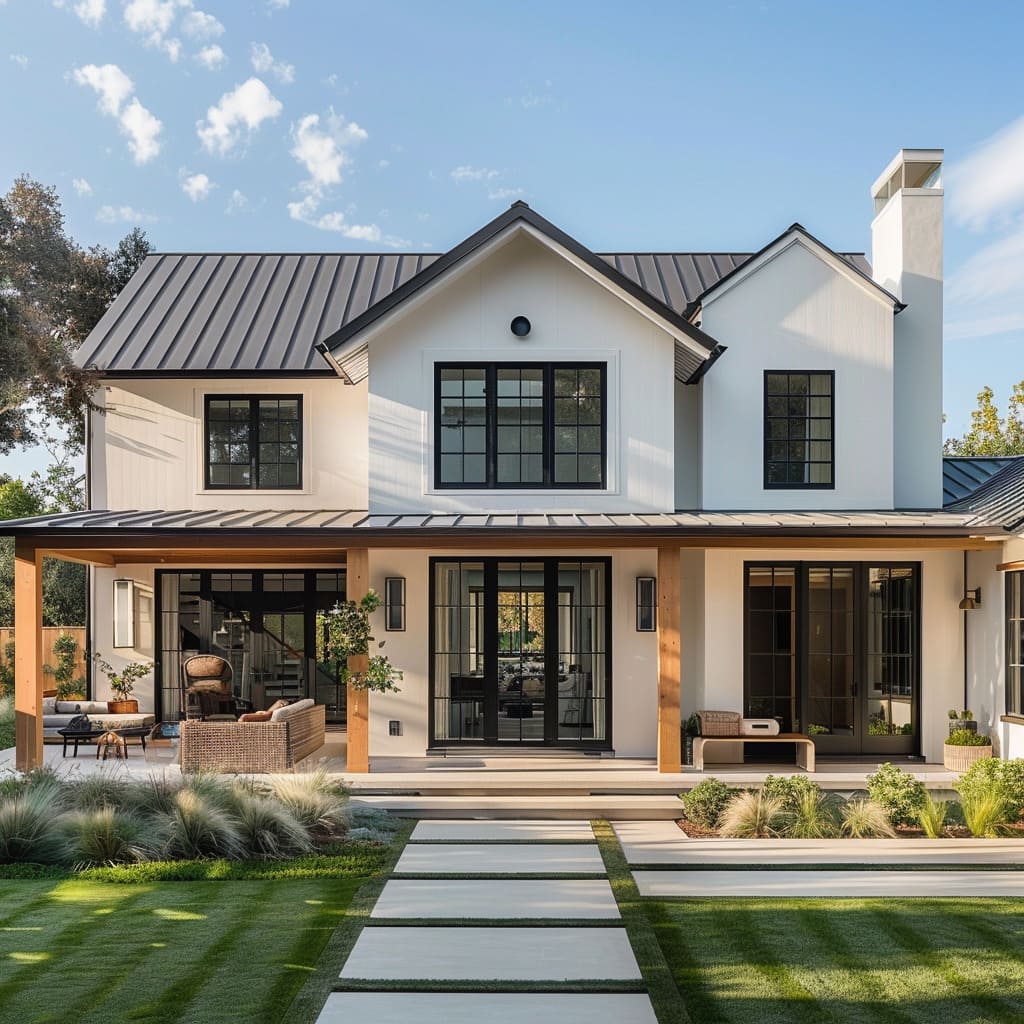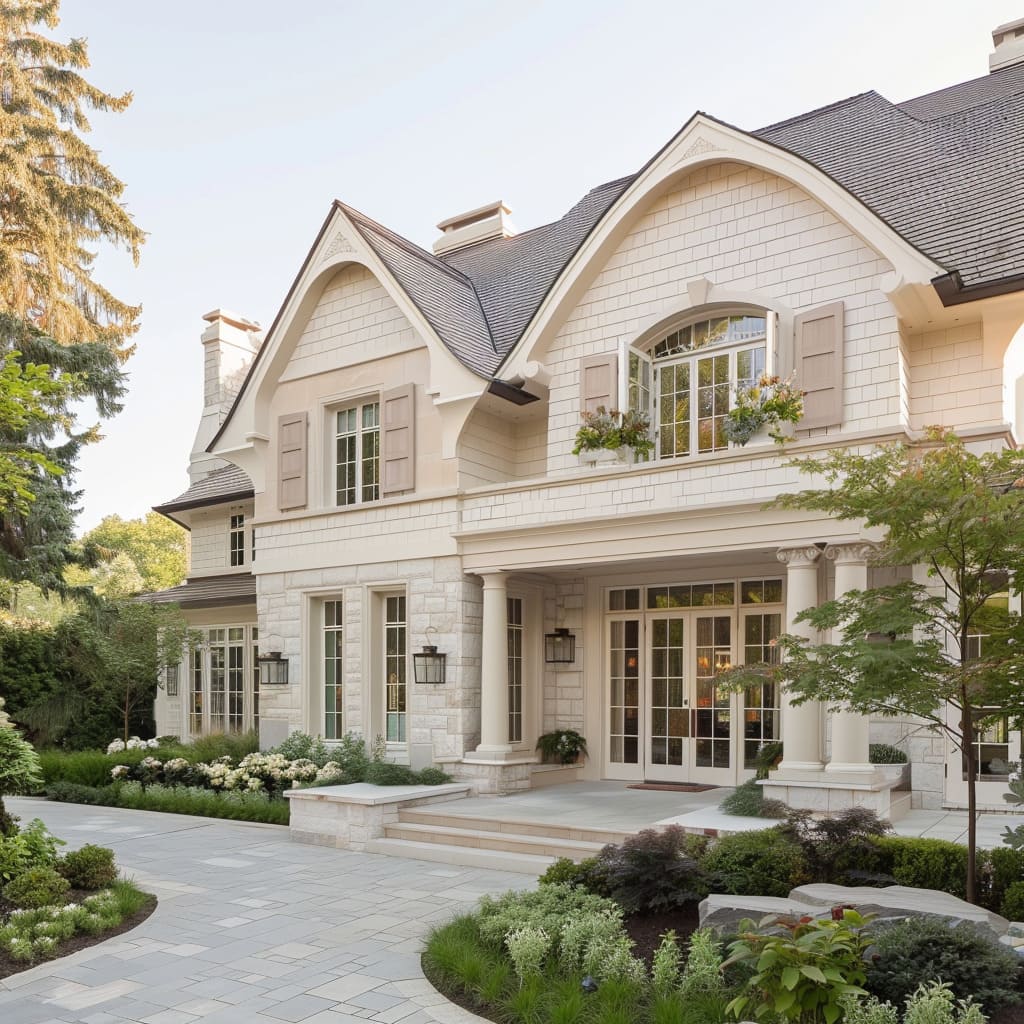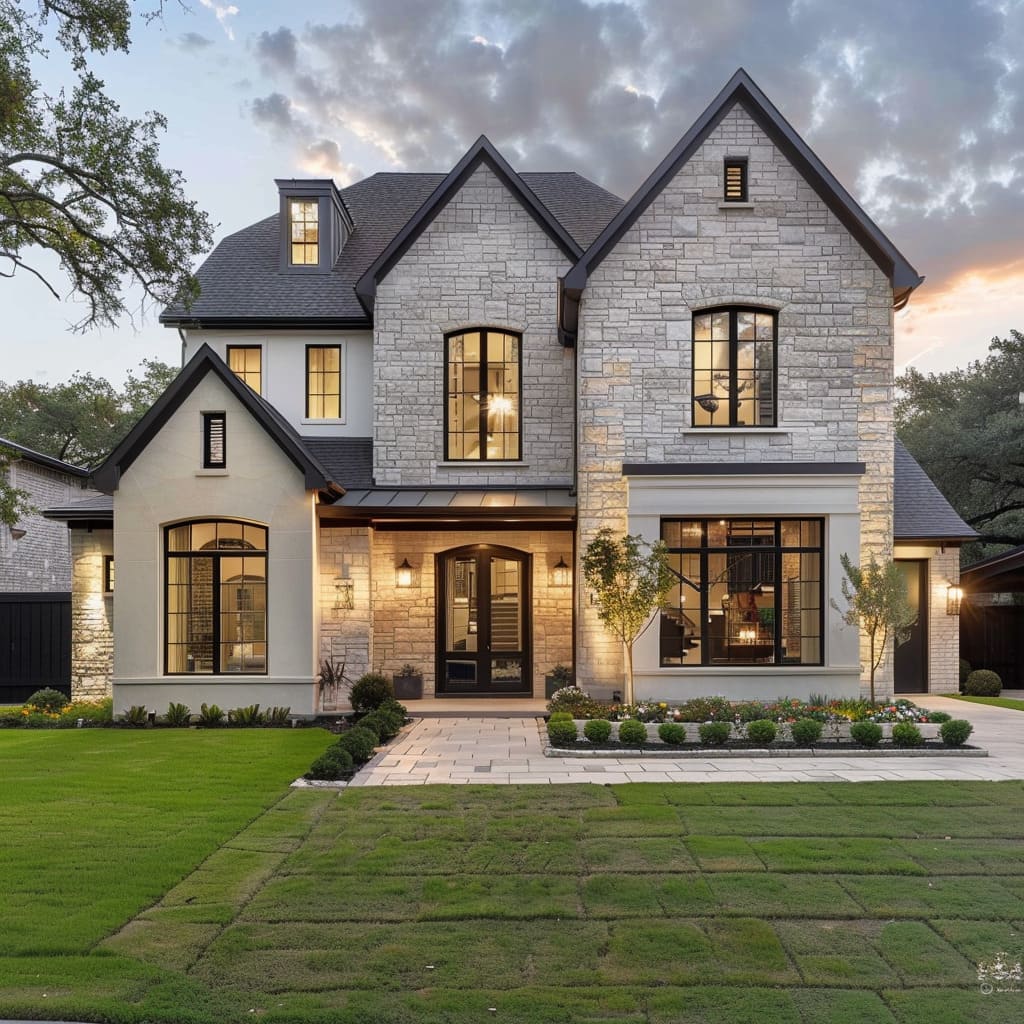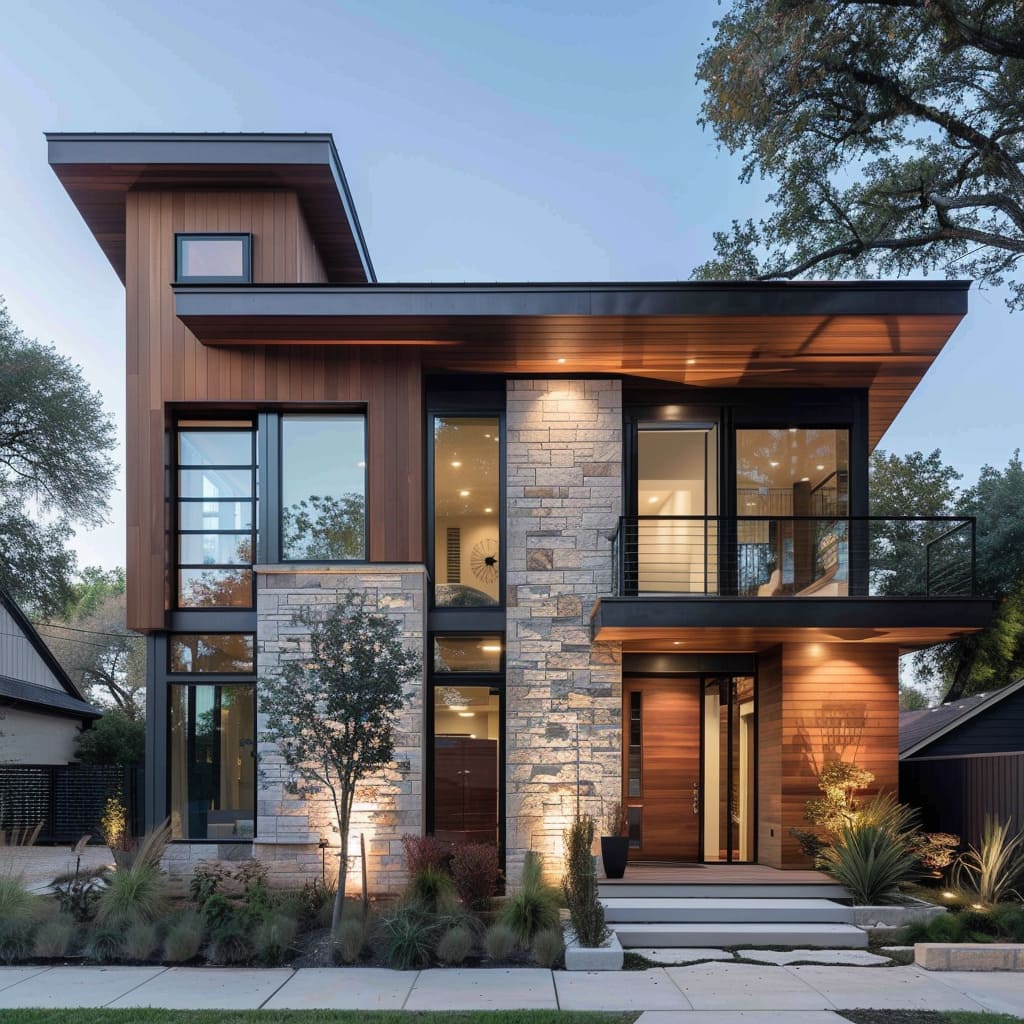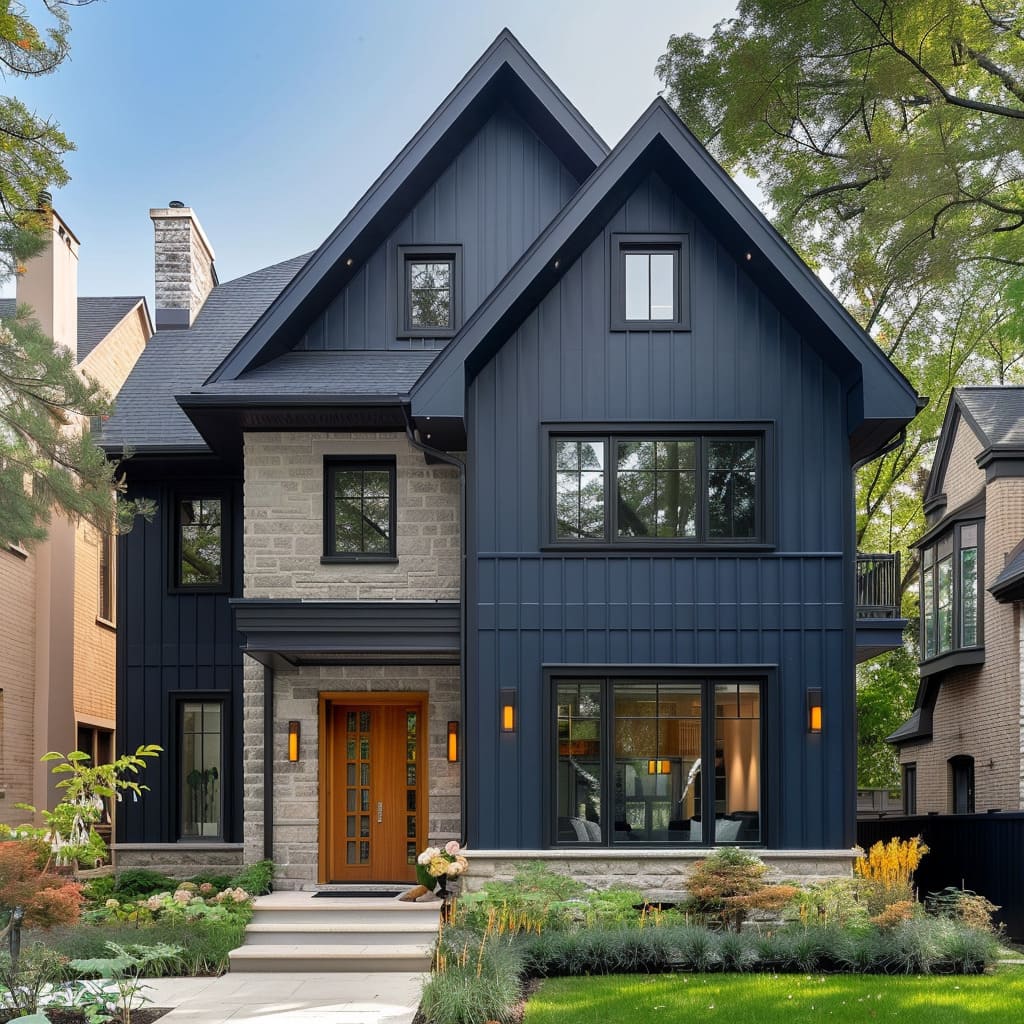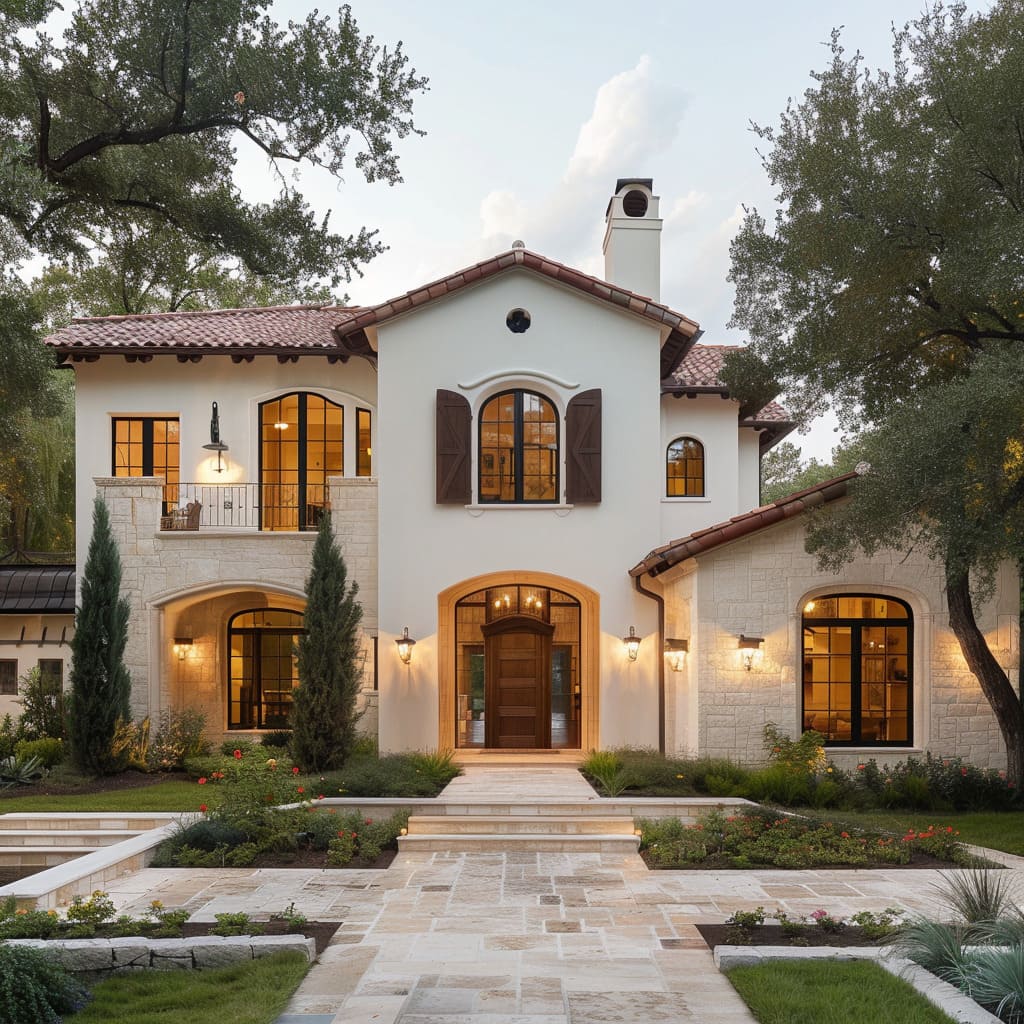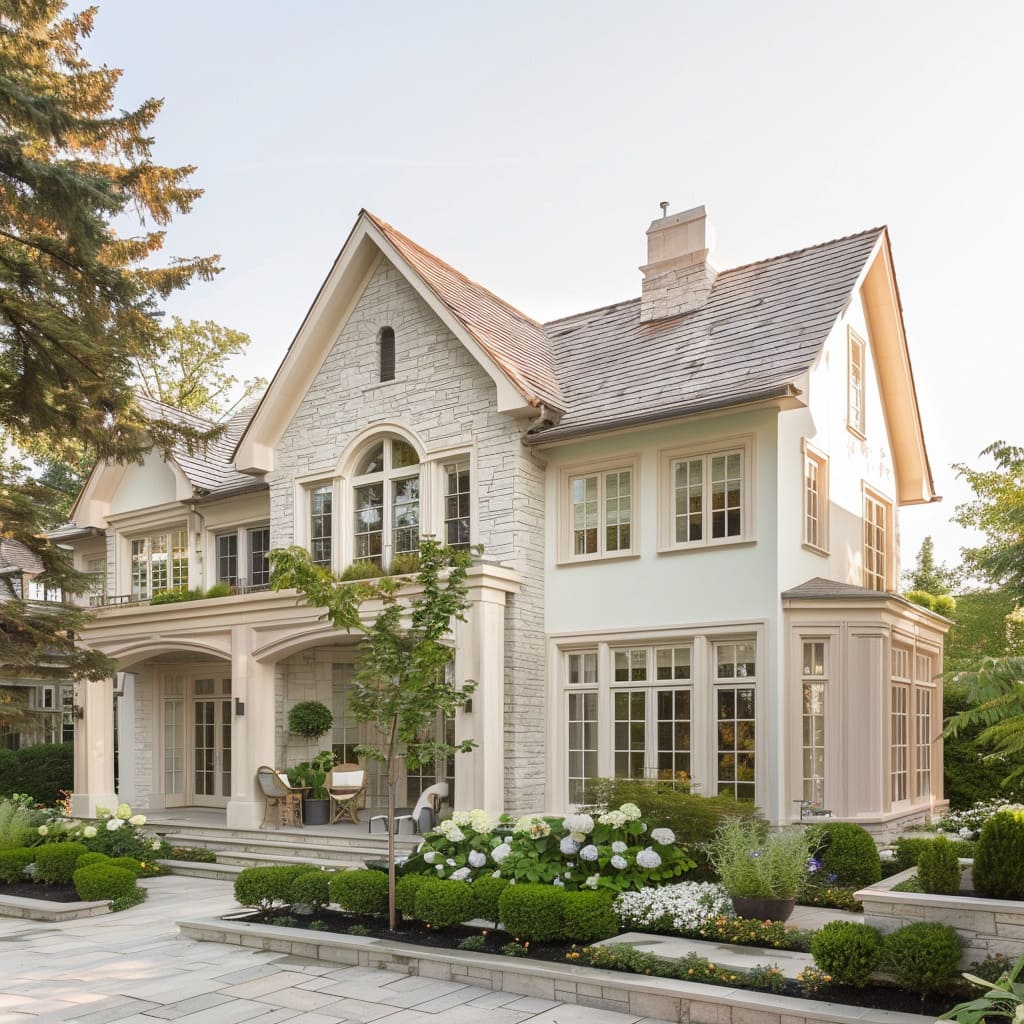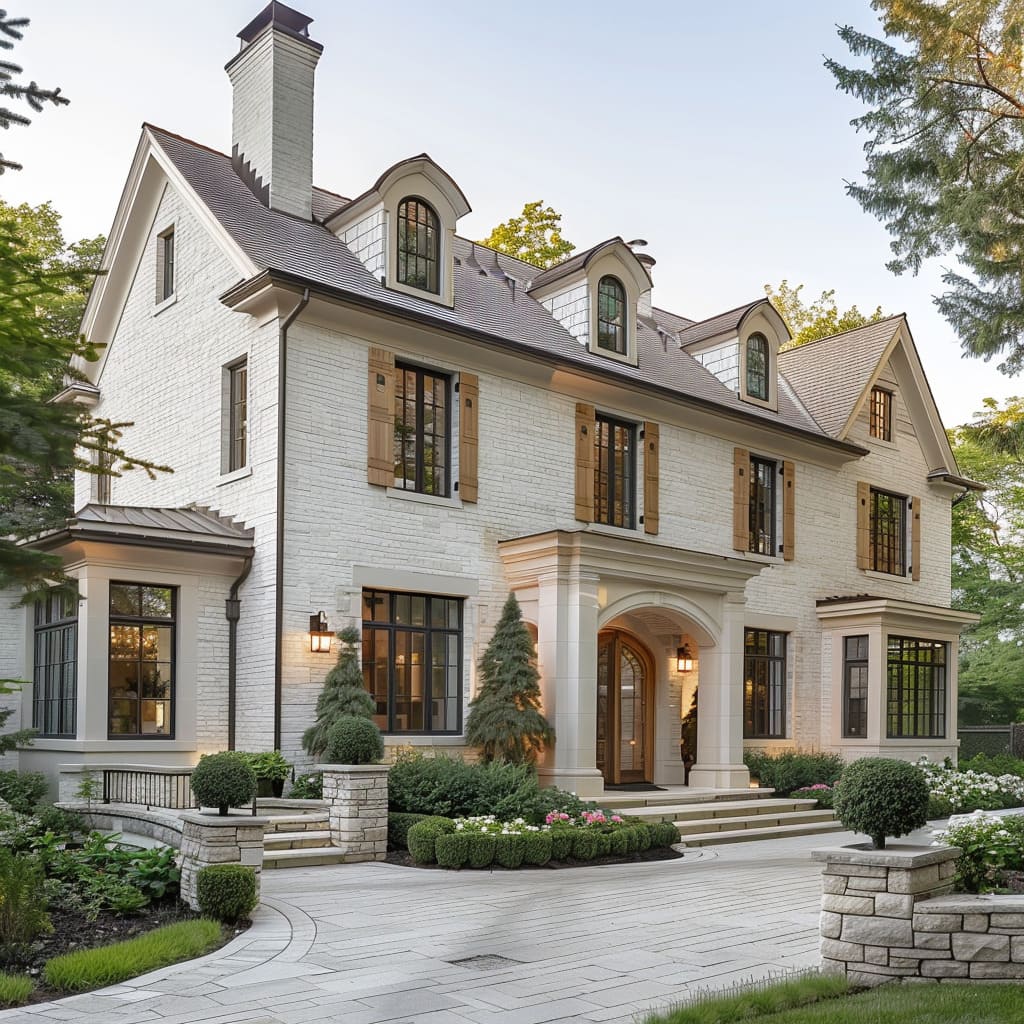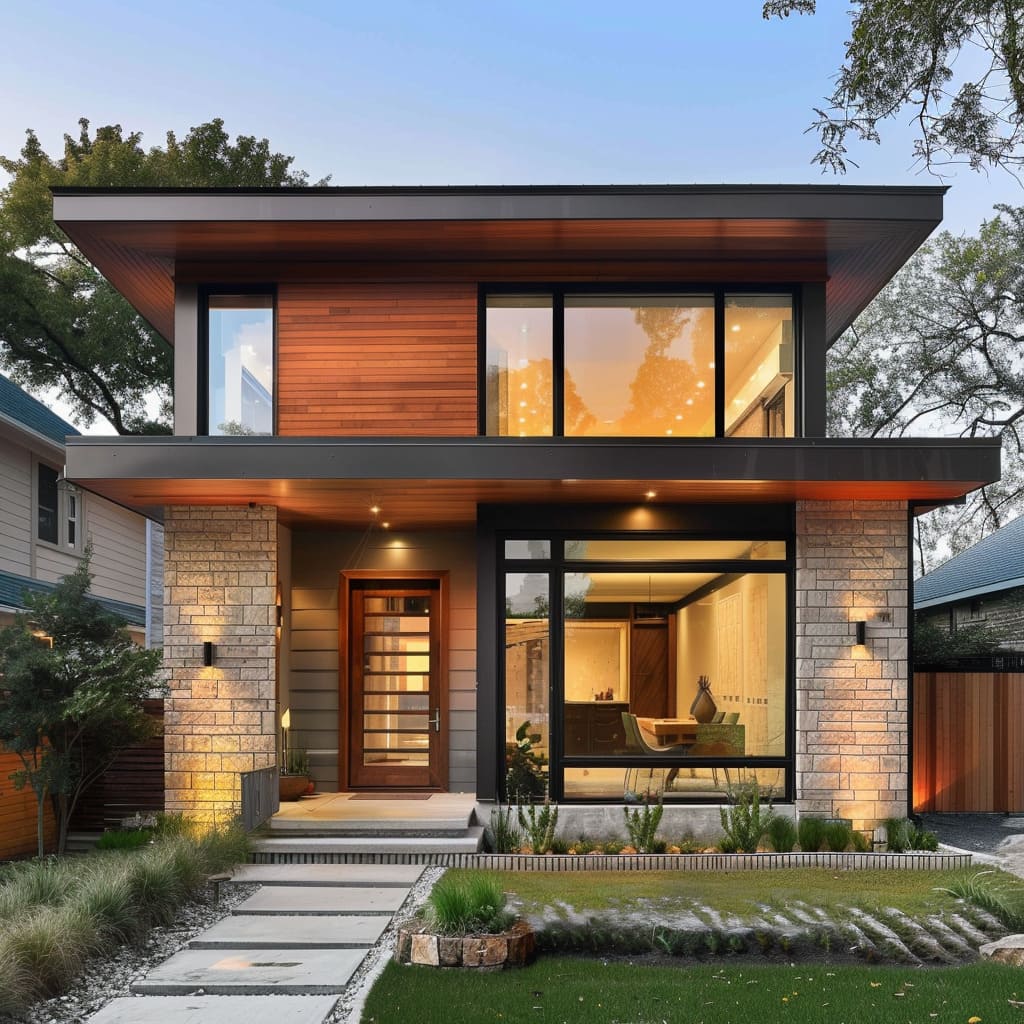In the heart of America’s diverse architectural landscape, the modern farmhouse style stands out as a testament to the harmonious blend of past and present. This design philosophy, embraced by a myriad of homeowners across the nation, marries the rustic charm of rural architecture with contemporary finesse, creating spaces that are both inviting and visually striking.
The resurgence of this style speaks volumes about our collective yearning for simplicity and warmth, wrapped in a design that echoes historical sensibilities while embracing modern living.
The modern farmhouse style is not merely a nod to the agrarian lifestyles of the past; it is a reimagining that incorporates the best of both worlds. The exterior design of these homes showcases a meticulous attention to detail and a reverence for the materials and forms that have stood the test of time.
The iconic gabled roofs, symmetrical facades, and the use of natural materials such as wood and stone reflect a connection to the earth and to the very essence of home-building.
Yet, this style does not shy away from modernity. It boldly integrates contemporary elements, from expansive windows to innovative use of space, demonstrating that practicality and beauty can coexist.
The modern farmhouse is a canvas for personal expression, allowing homeowners to craft spaces that truly reflect their values and lifestyles. It’s a style that respects tradition while offering the flexibility and comfort demanded by contemporary life.
The appeal of the modern farmhouse in the U.S. also lies in its versatility.
Whether nestled in a serene countryside or standing proudly in a suburban neighborhood, these homes offer a sense of sanctuary and simplicity that is increasingly sought after in today’s fast-paced world. They represent a return to basics—a celebration of natural materials, light-filled spaces, and a connection to the outdoors, all while providing a sophisticated backdrop for living.
In essence, the popularity of the modern farmhouse style is a reflection of our collective desire for homes that are not only functional and beautiful but also deeply resonant with our roots and aspirations. It’s a style that acknowledges the past, celebrates the present, and looks forward to the future, offering a timeless appeal that continues to captivate the American imagination.
If you are interested in modern exterior designs, explore the sleek and innovative features of modern architecture in our latest analysis, showcasing the best in current building trends.
Time-Honored Architectural Features
Traditional architectural elements are foundational to the modern farmhouse look, giving these homes a timeless and classic appearance. The steep Gabled Roof, characteristic Board and Batten Siding, and Symmetrical Facades are reminiscent of the original farmhouses, while Large Front Porches offer a welcoming entrance.
These features are appreciated for their historical roots and their adaptation to contemporary aesthetics, ensuring the home looks both established and modern.
The very essence of farmhouse design is captured in the Simplicity in Form, where clean lines and a lack of unnecessary adornment speak to a no-nonsense approach to residential architecture. This simplicity does not equate to plainness, however; it serves to highlight the structure’s beauty without overwhelming the senses.
The Gabled Roof not only provides an aesthetic that resonates with historical rural constructions but also offers practical benefits, such as efficient water runoff and additional attic space, which may be utilized for various purposes.
Board and Batten Siding adds a dimensional texture to exteriors, with its pattern of narrow strips (battens) placed over the seams of wide boards. This siding is not only visually appealing but also provides an effective barrier against the elements, embodying a union of form and function.
The inclusion of Large Front Porches extends the living space into the outdoors, creating an inviting threshold that encourages interaction with neighbors and passersby. These porches often feature ample space for seating, hinting at a communal lifestyle and love for the open air.
Symmetrical Facades are visually soothing and convey a sense of order and stability. This symmetry, seen in the balanced placement of windows and the central positioning of the doors, gives the impression of a well-thought-out design that respects traditional building practices.
The presence of Double Front Doors not only makes for an impressive entry but also facilitates the movement of larger items and allows for more light and air to circulate when open, enhancing the home’s connection to its surroundings. Together, these features form a welcoming aesthetic that is both functional and heartening, echoing a heritage of construction that is both grounded and refined.
The Harmony of Contrasts
In modern farmhouse design, the interplay of contrasting elements is crucial. Contrasting Color Palettes of darks against lights, particularly the use of white, define the modern farmhouse’s exterior, highlighting its architectural details.
The Use of Natural Materials like stone and wood against more modern materials creates a tactile experience that is visually engaging and grounded in nature.
In modern farmhouse design, the Contrasting Color Palettes bring a distinct character to the homes. Darker shades ground the structure, while the lighter tones, particularly the widespread use of white, reflect light and give the homes a certain luminosity as the sun sets or rises.
This contrast is not just in color but also in texture; the dark hues often belong to elements like window frames, roofing, or shutters, which stand out against the smoother, lighter-colored siding.
The Use of Natural Materials plays a significant role in the overall ambiance of the farmhouse design. Stone foundations suggest sturdiness, wood elements connect the structure to the surrounding landscape, and brick accents offer a touch of classical craftsmanship.
These materials are chosen not only for their durability and ability to withstand the test of time but also for their intrinsic beauty, which matures with age.
A continuation of this theme is seen in the Neutral Interior Color Schemes, which often extend subtly to the exterior through window frames and the visible thresholds between outside and inside. These palettes create a serene backdrop that complements the natural environment, making the transitions between the built environment and the natural world less stark.
These design elements come together to create a residence that feels anchored in tradition yet is distinctly current. The contrasting colors and materials, set against neutral tones, result in a visually striking home that offers warmth and welcomes relaxation.
The combination speaks to a desire for balance—homes that are as open and airy as they are cozy and intimate.
Modern Adaptations
Modern farmhouses stand out for their Innovative Use of Space and Modern Lines and Features. They incorporate elements like Standing Seam Metal Roofs and Expansive Windows which are emblematic of modern construction.
These homes are not only beautiful; they’re designed to accommodate contemporary lifestyles, blending old-world charm with new-world functionality. Garage Placement that complements the main house in design and material choice also falls into this category, showcasing the seamless blend of function and form.
The Innovative Use of Space in modern farmhouses is a direct response to the evolving desires for efficiency and versatility within home design. These homes often feature well-thought-out nooks that serve multiple purposes – as a cozy reading spot, a storage area, or a display for art and memories.
The intentionality of the design optimizes every square inch of the home, ensuring that form and function are in constant dialogue.
Modern Lines and Features of the contemporary farmhouse fuse the warm spirit of traditional homes with the clean, geometric silhouettes of today’s style. This can be seen in the precise way eaves are cut or how porches are framed with minimalist columns that add a fresh perspective to the classic American farmhouse, offering a visual feast that is both familiar and fresh.
The Standing Seam Metal Roofs are a signature element of this style, with their uninterrupted lines running from the ridge to the eaves, providing not only a weather-tight covering but also contributing to a polished appearance. These roofs are not just about allure; they represent an investment in durability and sustainability, reflecting sunlight and providing improved insulation.
Expansive Windows in modern farmhouses are strategic, not only for the illumination they provide but also for the seamless integration they offer between the interior and exterior spaces. These windows often serve as the walls themselves, opening up rooms to expansive views and allowing inhabitants to feel as though nature is an accessible extension of their living space.
Lastly, the Garage Placement is a thoughtful consideration in modern farmhouse design. Whether attached to the main structure or standing alone, garages are carefully positioned to maintain the aesthetic integrity of the property while providing practical vehicle storage and often doubling as additional workspace or storage.
The design ensures that they are not an afterthought but an integral part of the property’s overall composition.
Sustainable and Smart Living
An increasing number of homeowners are seeking sustainable living options, and modern farmhouses often incorporate these preferences. Sustainable Elements such as solar panels and Smart Home Features cater to the environmentally conscious and technologically savvy.
Energy-efficient windows and other green building techniques contribute to a home that is both eco-friendly and comfortable.
The concept of Sustainable Elements in the modern farmhouse style goes beyond mere aesthetics. Solar panels, which may not be immediately visible from the street view, are increasingly common and represent a commitment to renewable energy sources.
They are indicative of a forward-thinking approach to living, where environmental responsibility is as important as visual appeal. Energy-efficient windows are another hallmark of this approach, often large to allow for ample natural lighting, which reduces the need for artificial illumination and helps regulate the interior climate.
Smart Home Features embody the convergence of convenience and innovation. Home automation systems that control lighting, climate, and security are becoming standard in modern farmhouses, reflecting the homeowners’ inclination towards streamlined, efficient living.
These systems can often be monitored and controlled remotely, providing peace of mind and flexibility.
Integrating these features creates homes that are not only responsive to the needs of their inhabitants but also to the broader environmental impact. The combination of sustainable building practices and smart technology results in homes that are efficient, cost-effective, and comfortable, setting a new standard for residential design.
These intelligent homes cater to those who value both rural charm and urban sophistication, offering a lifestyle that respects both the past and the future.
Interior-Exterior Continuity
A distinctive feature of the modern farmhouse is the seamless Indoor-Outdoor Flow. Elements like French doors or large porches blur the lines between inside and outside, inviting the outdoors in.
The continuity between these spaces is a major draw for those who enjoy nature and entertaining, reflecting a laid-back, sociable lifestyle that many find appealing. The blending indoor and outdoor spaces is further exemplified by Functional Outdoor Spaces like patios and decks, which extend living spaces outside.
Ceiling Treatments such as vaulted ceilings or skylights, sometimes visible from outside, suggest a continuity of style and an emphasis on airy, open living areas.
The Indoor-Outdoor Flow is an essential component of the modern farmhouse, blurring the boundaries between the home’s interior and the natural world outside. French doors and sliding barn doors are often incorporated into these designs, offering broad, welcoming entrances to outdoor spaces.
Not only do these elements provide practical benefits, such as ease of movement and natural ventilation, but they also contribute to the aesthetics of open living and the fluid transition from indoors to outdoors.
Functional Outdoor Spaces such as patios and decks are carefully crafted extensions of the interior living areas. These spaces frequently serve as venues for social gatherings, quiet relaxation, and dining al fresco.
They are designed with an eye for style and a consideration for the environment, using materials and plants that complement the natural surroundings and enhance the user experience.
Ceiling Treatments play a pivotal role in defining the character of both the interior and exterior of modern farmhouses. Vaulted ceilings create an impression of expansiveness and airiness within the home, while skylights punctuate these overhead spaces, inviting in the sky and stars.
From the outside, the lines of the vaulted roofs are often visible, contributing to the distinct silhouette of the home against the landscape.
These design elements work in concert to establish a residence that embodies the ideals of open space and connectivity with the environment. The transitions between inside and outside are seamless, promoting a lifestyle that takes full advantage of the surroundings.
The modern farmhouse becomes a sanctuary that fosters a strong sense of place and a harmonious living experience.
Comfort and Craftsmanship
Finally, the interior elements that occasionally show through in the exterior design, such as Exposed Wood Beams or ceiling details visible through windows, suggest a level of comfort and craftsmanship that is carried throughout the home. Durable Flooring and luxury touches visible from the outside signal a home that is built to last and cherished for its quality.
Exposed Wood Beams have long been a hallmark of the farmhouse aesthetic, providing a visual connection to nature and a sense of enduring craftsmanship. When these beams are visible from the exterior, they hint at the structural integrity and rustic beauty that lies within.
They frame living spaces and often extend to outdoor areas, like porches or patios, maintaining the rustic theme throughout the property.
The use of Durable Flooring materials, especially hardwood, reinforces the blend of comfort and resilience in modern farmhouse design. Hardwood not only withstands the wear and tear of daily life but also grows more attractive with age, developing a rich patina that adds to the home’s overall warmth.
These floors are also a practical choice, as they are easier to clean and maintain than other types of flooring, making them ideal for a home that’s both lived-in and loved.
A Mix of Old and New Furnishings further emphasizes the eclectic charm of farmhouse living. Vintage pieces might be reimagined with contemporary fabrics or set alongside modern designs, creating spaces that feel curated over time.
This approach to decor reflects an appreciation for history and craftsmanship, as well as a recognition of the comforts of modern living.
These aspects of design—the wood beams, the flooring, and the furnishings—combine to create a home that is rich in texture and history, yet fully equipped for modern living. They underscore the value placed on both form and function, tradition and innovation, making the modern farmhouse a testament to a well-balanced lifestyle.
As we traverse the dynamic landscape of American residential architecture, the modern farmhouse style emerges as a beacon of balance, blending the cherished elements of yesteryear with the demands of today’s living. This style’s soaring popularity across the United States is a testament to its ability to resonate deeply with a broad spectrum of homeowners, offering a sanctuary that is as comforting as it is contemporary.
At the core of the modern farmhouse’s appeal is its ability to evoke a sense of nostalgia while providing a canvas for personal expression and modern convenience. The architectural elements—steep gabled roofs, symmetrical facades, and the iconic board and batten siding—serve as a homage to the agricultural heritage of America, imbued with a sense of history and endurance.
Yet, these homes are far from mere relics of the past. They stand as a thoughtful fusion of time-honored design and modern innovation, accommodating the desires for open, adaptable living spaces that cater to today’s dynamic lifestyles.
The modern farmhouse transcends mere aesthetics, embedding functionality and sustainability into its design ethos. The integration of energy-efficient features and smart home technology speaks to a growing consciousness towards environmental stewardship and a desire for homes that are both intelligent and intuitive.
These elements, coupled with the style’s inherent connection to the natural world through its use of organic materials and expansive windows, underscore a commitment to living spaces that are not only beautiful but also mindful and sustainable.
Furthermore, the style’s versatility allows it to thrive in diverse settings, from rural landscapes to suburban neighborhoods, proving that the allure of the modern farmhouse is not confined by geography. It is a style that champions versatility, comfort, and a return to simpler, yet profoundly rich architectural traditions that resonate with a wide audience, seeking solace and simplicity in their homes.
In conclusion, the modern farmhouse style stands as a testament to the enduring appeal of rustic simplicity melded with contemporary comfort. It is a reflection of America’s evolving residential preferences, where the past is celebrated, the present is embraced, and the future is anticipated with homes that are as welcoming as they are wise.
As we look towards the horizons of American architecture, the modern farmhouse remains a significant and beloved chapter in the ongoing story of home design, embodying a lifestyle that values authenticity, comfort, and a deep connection to the essence of home.

